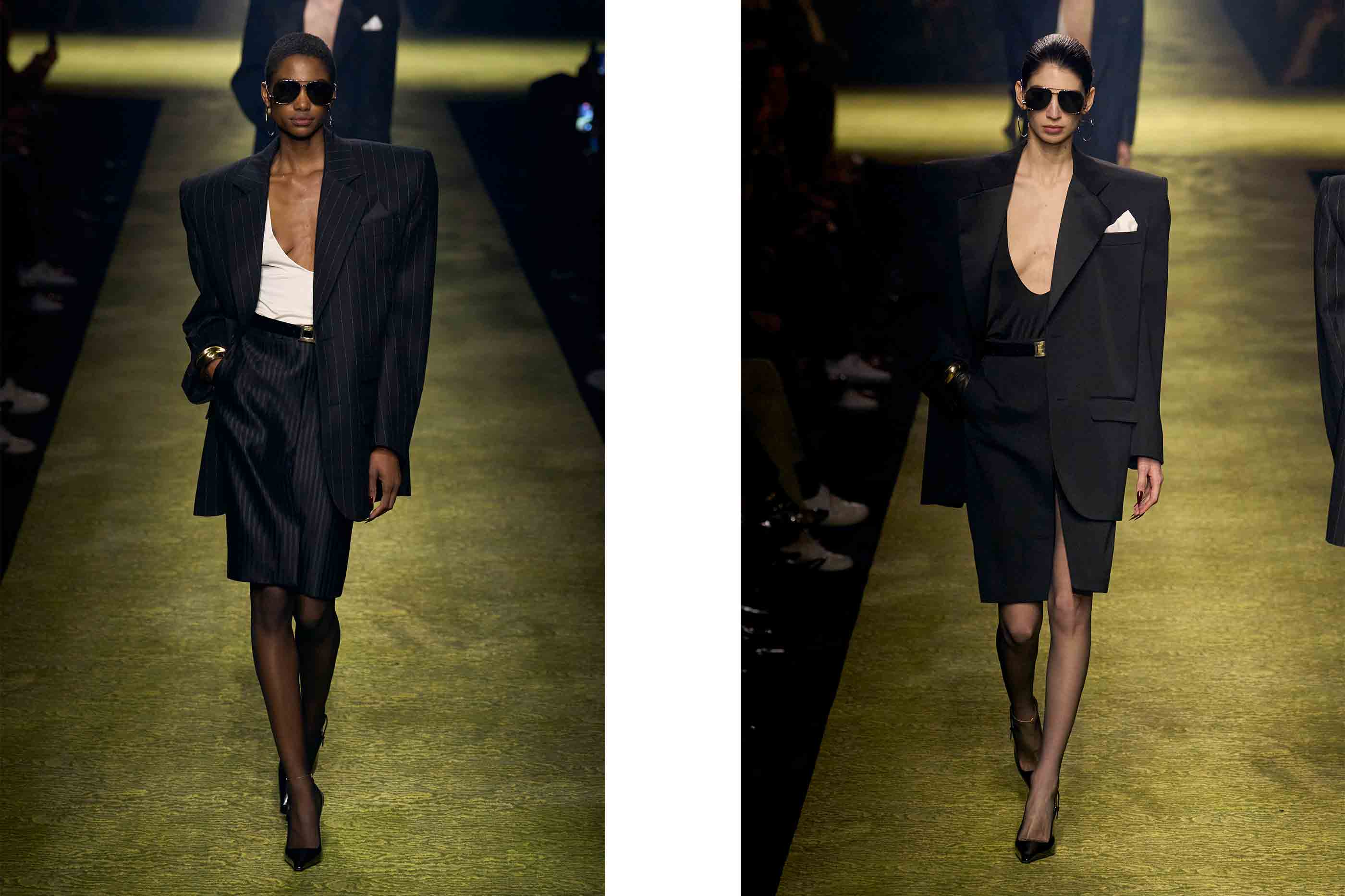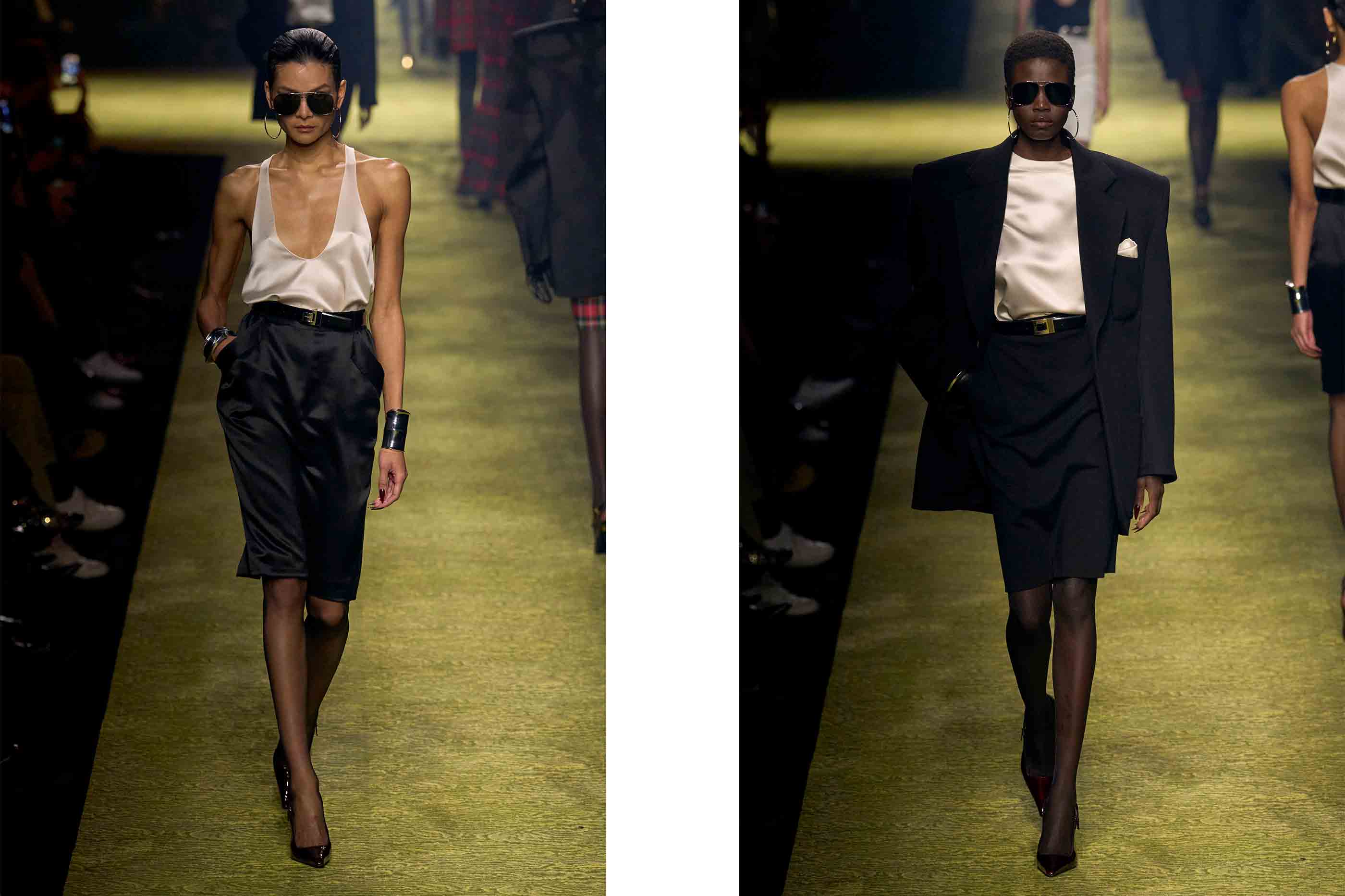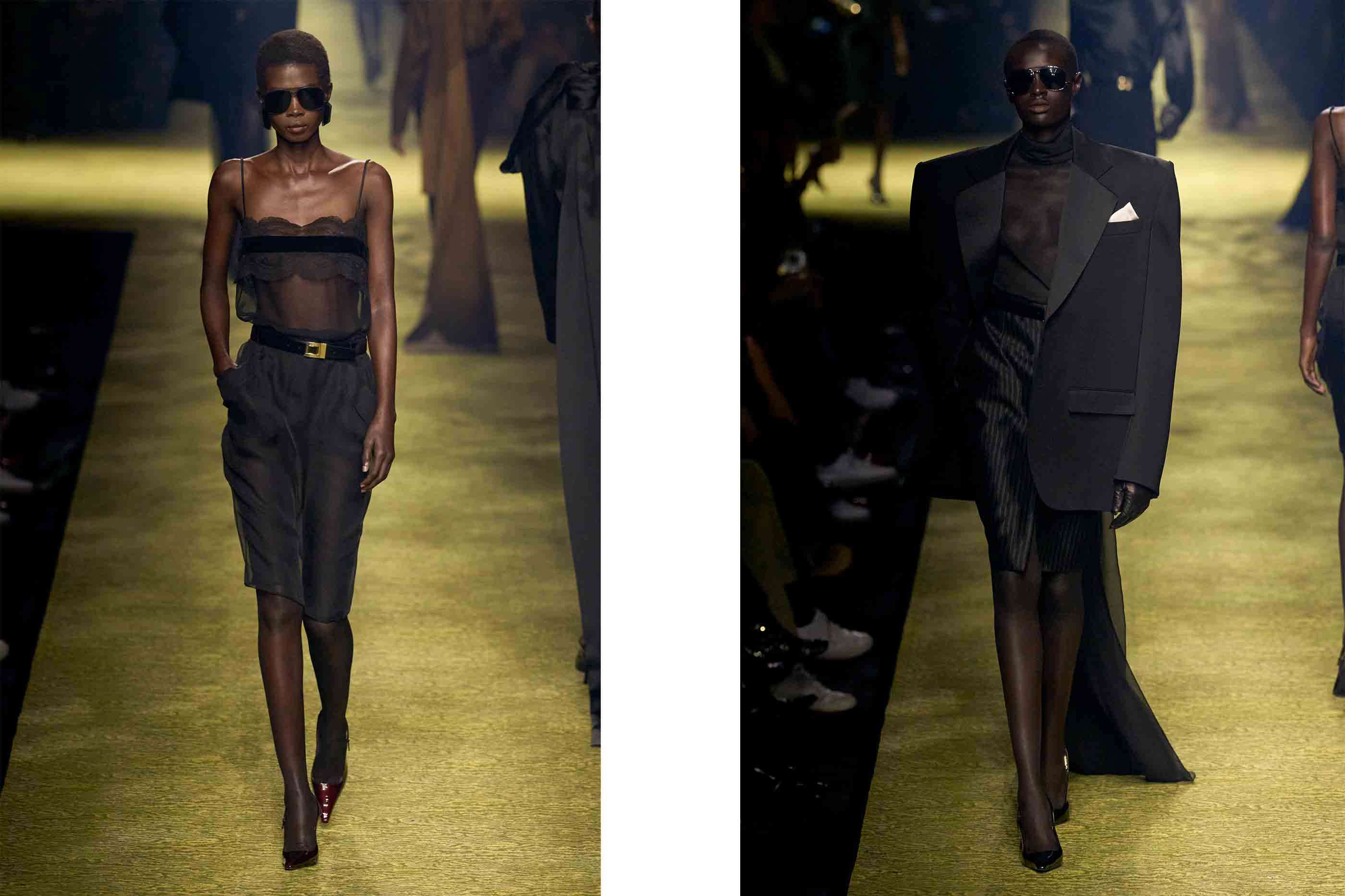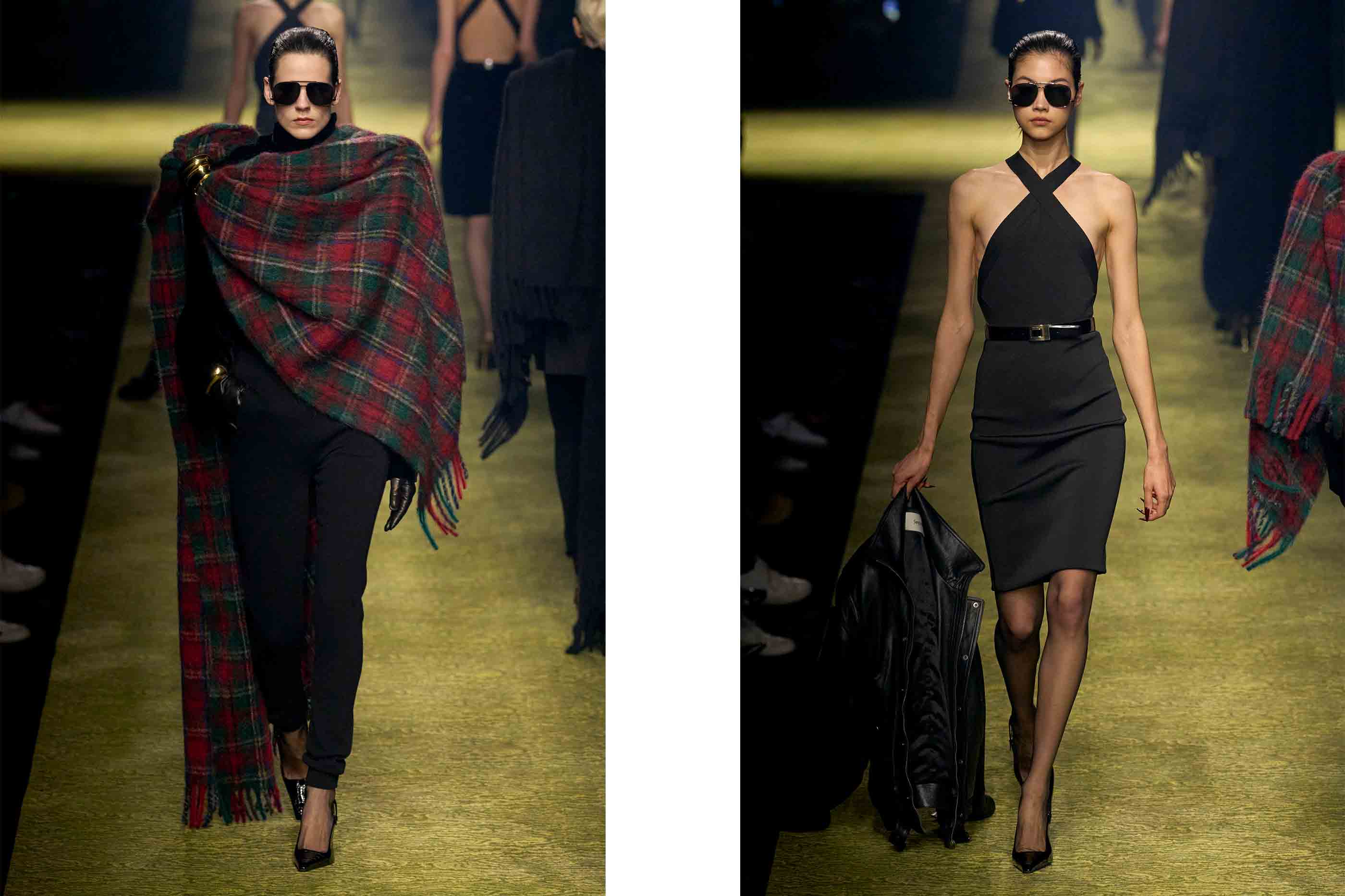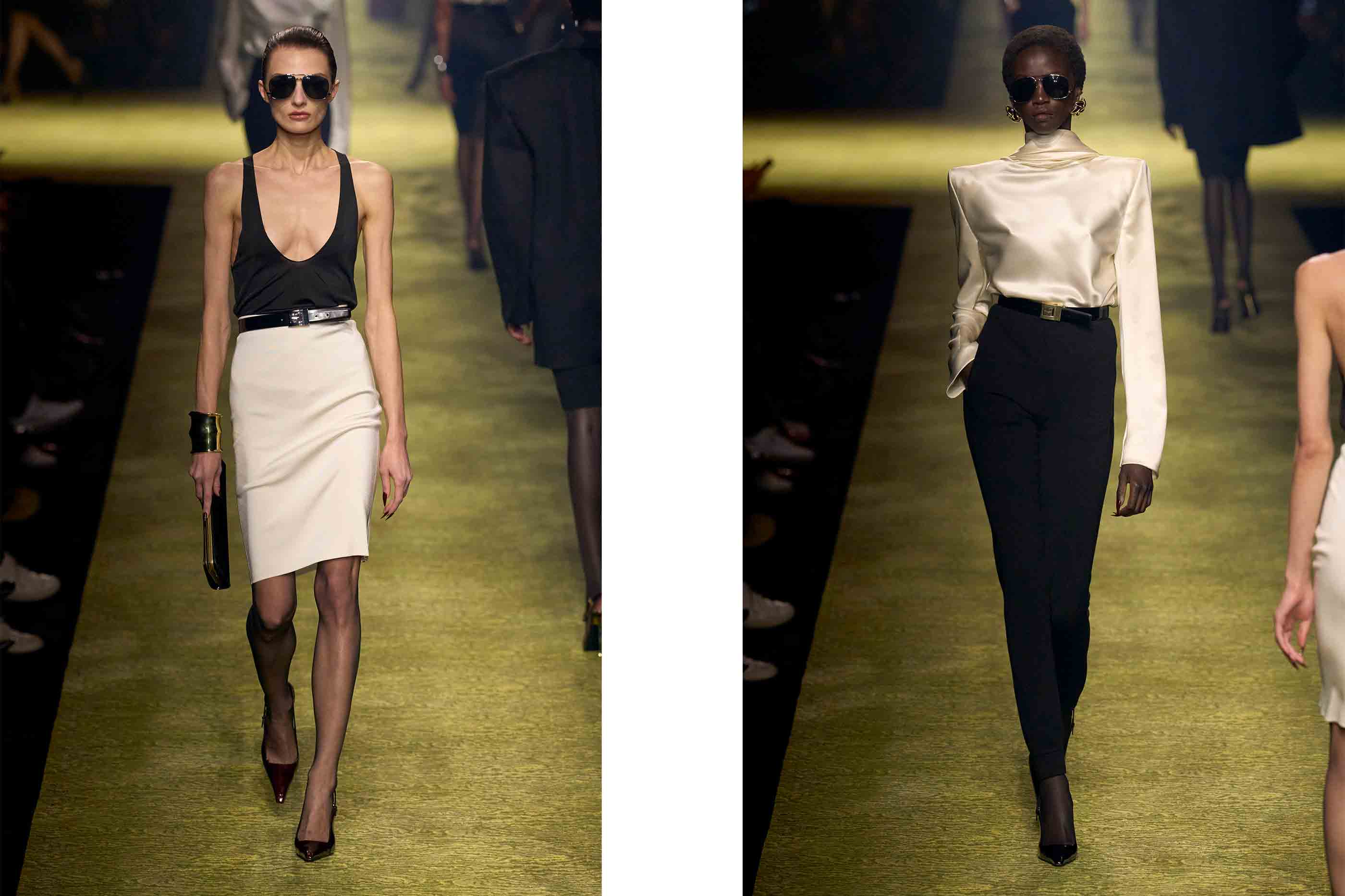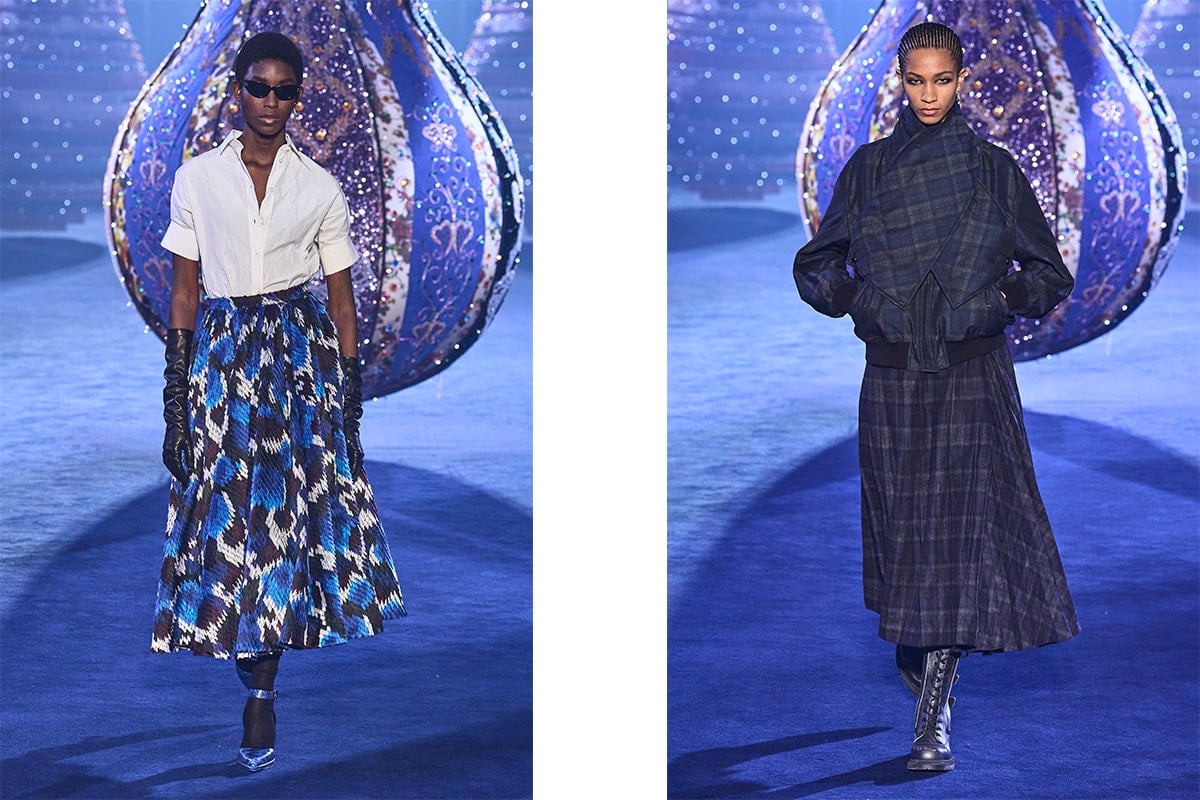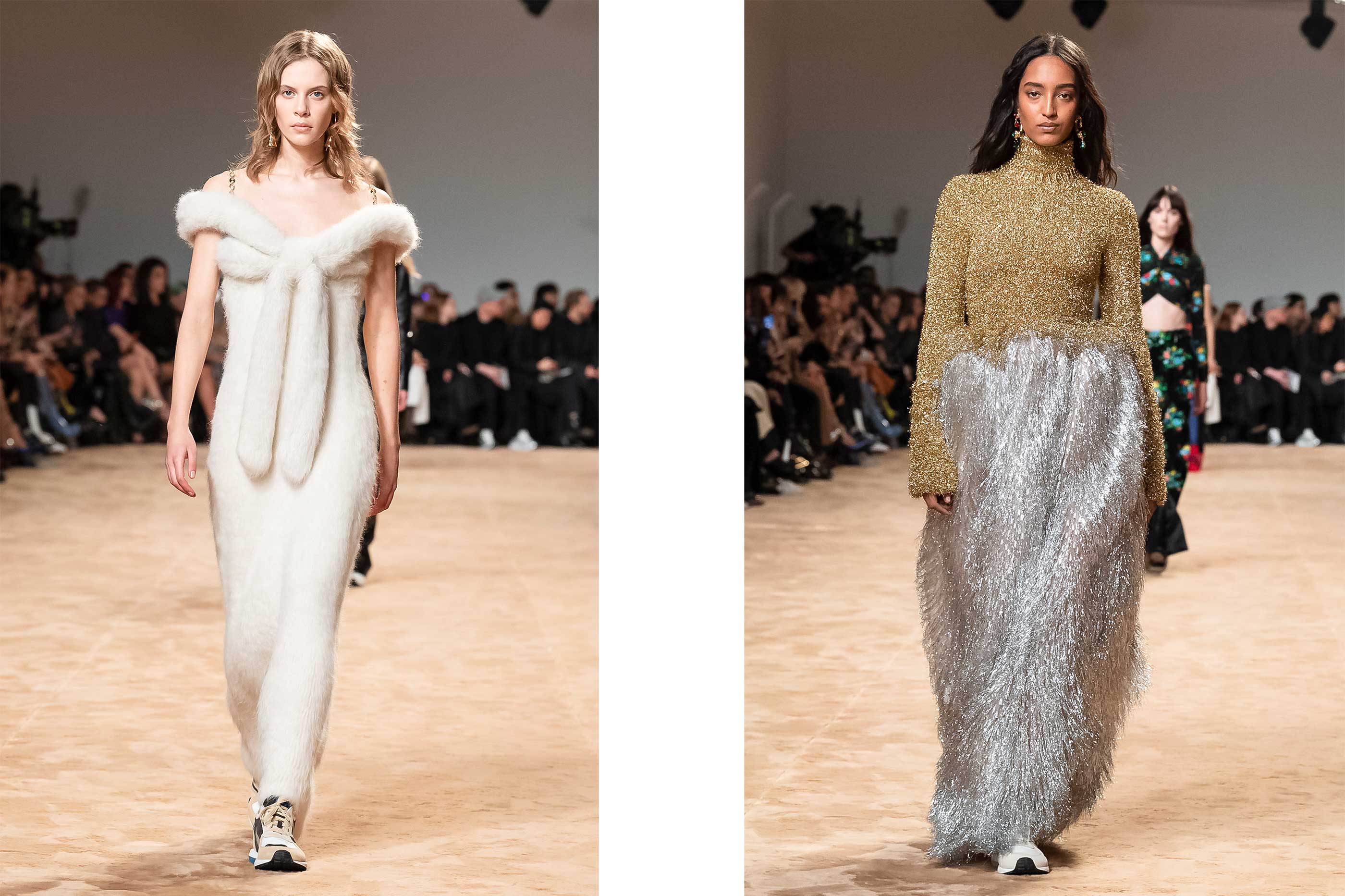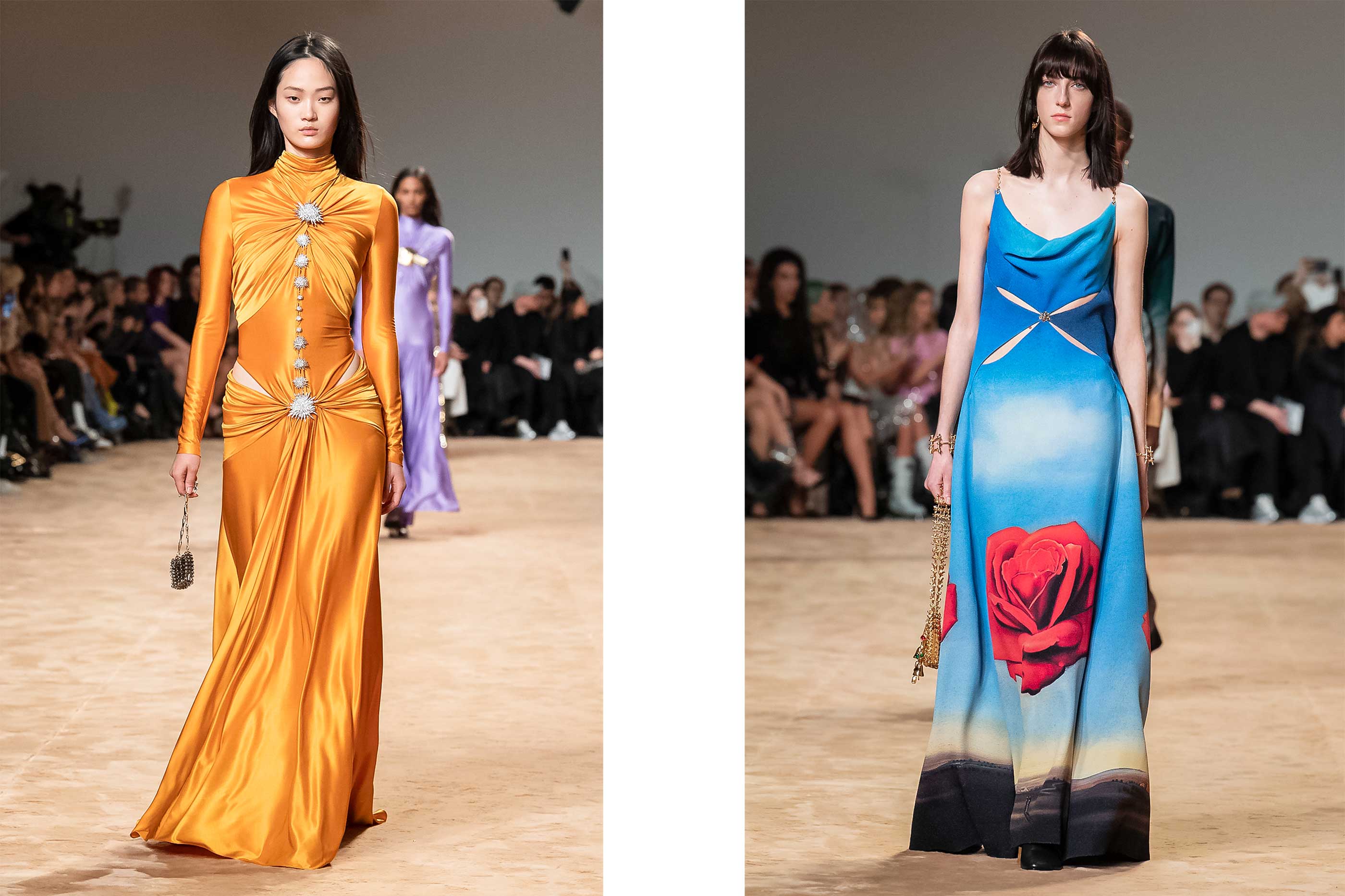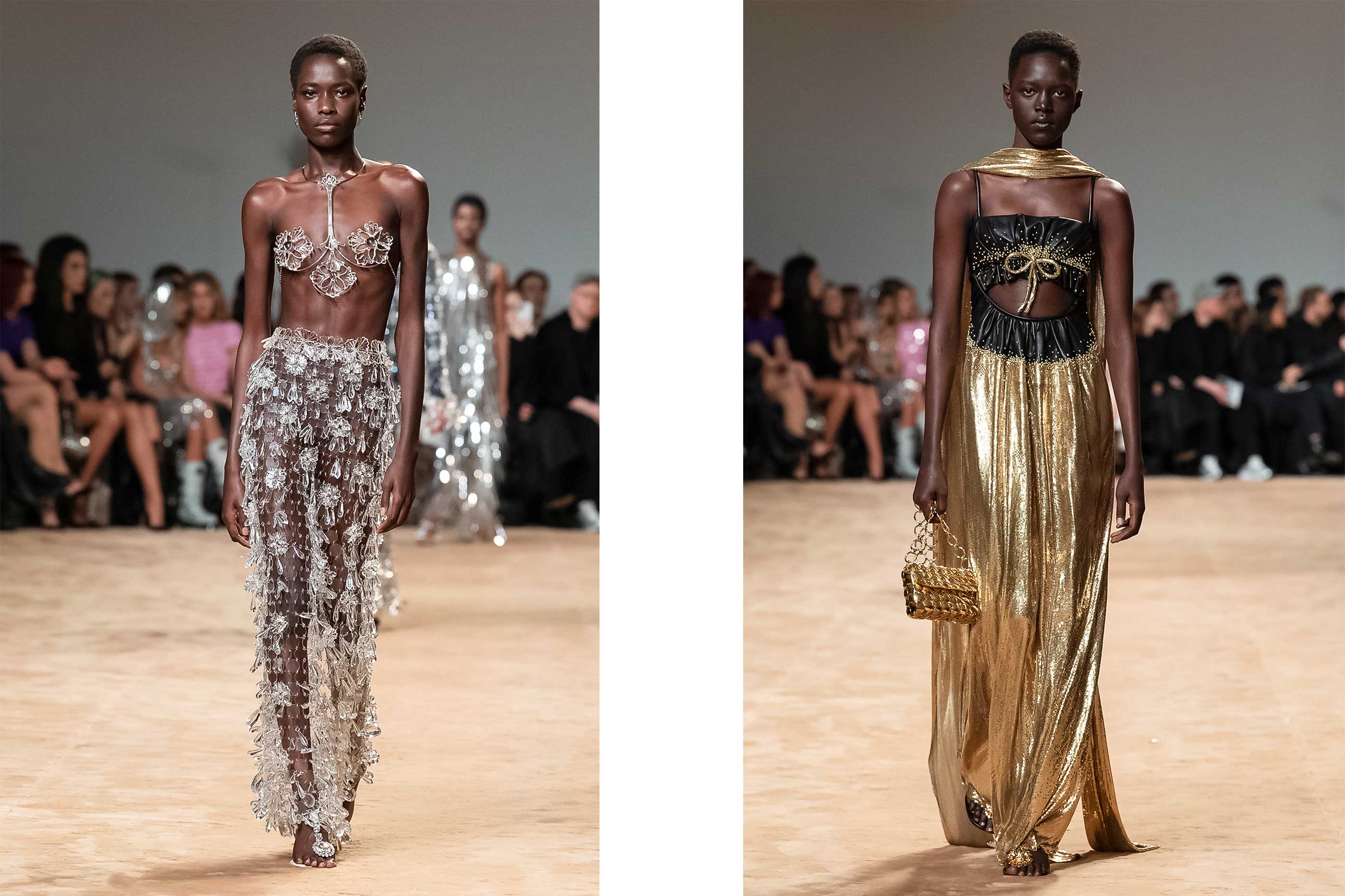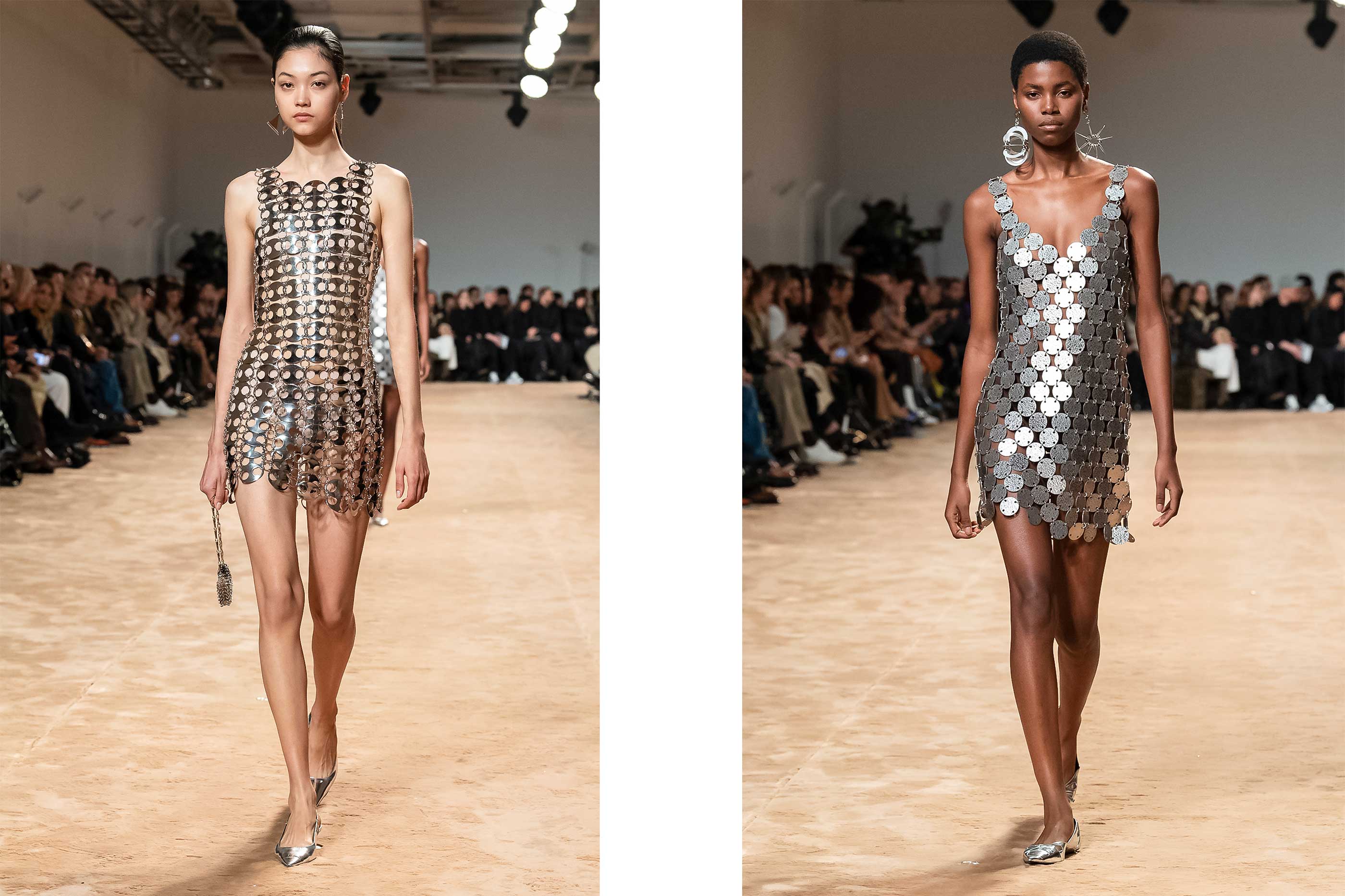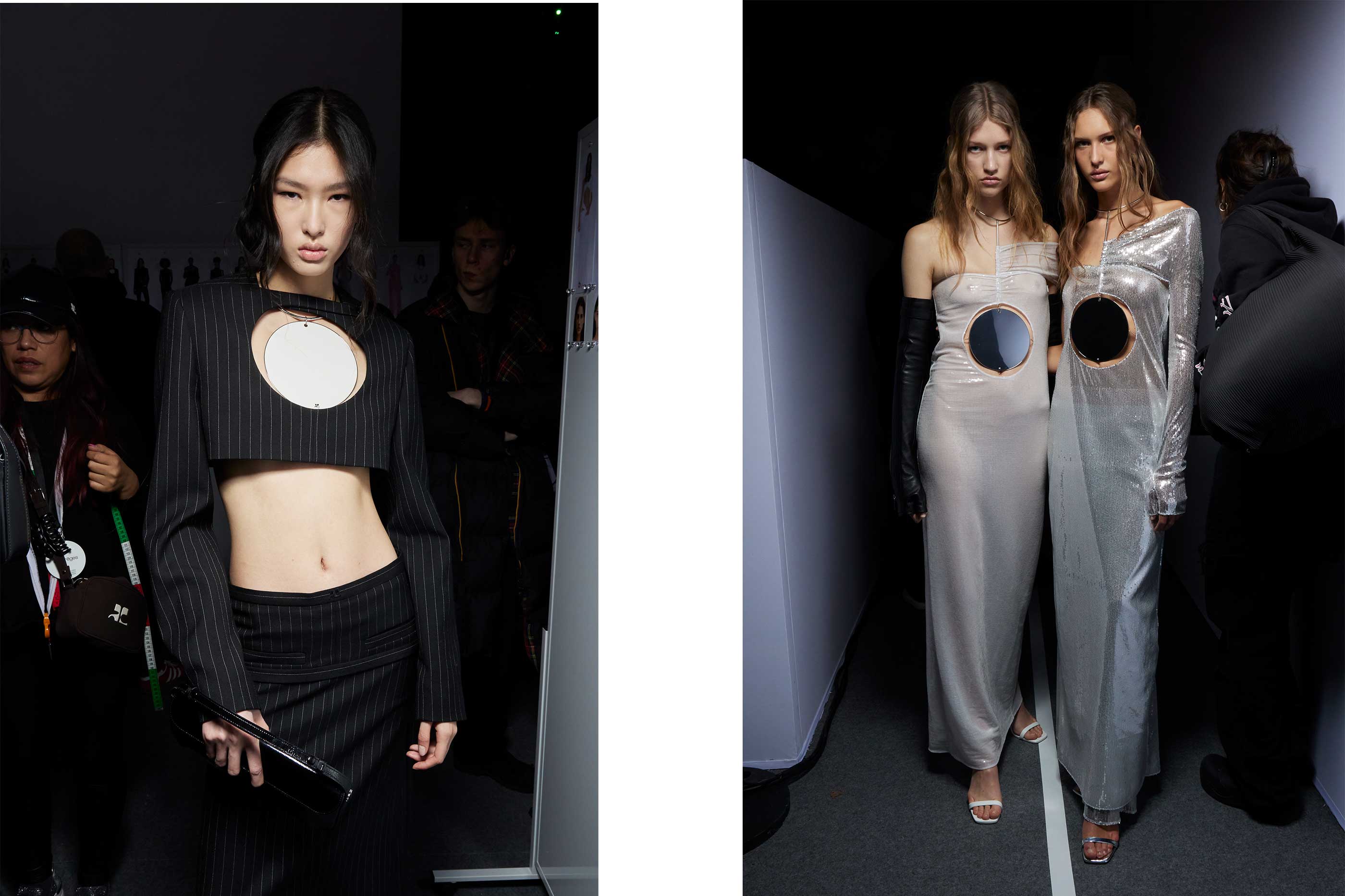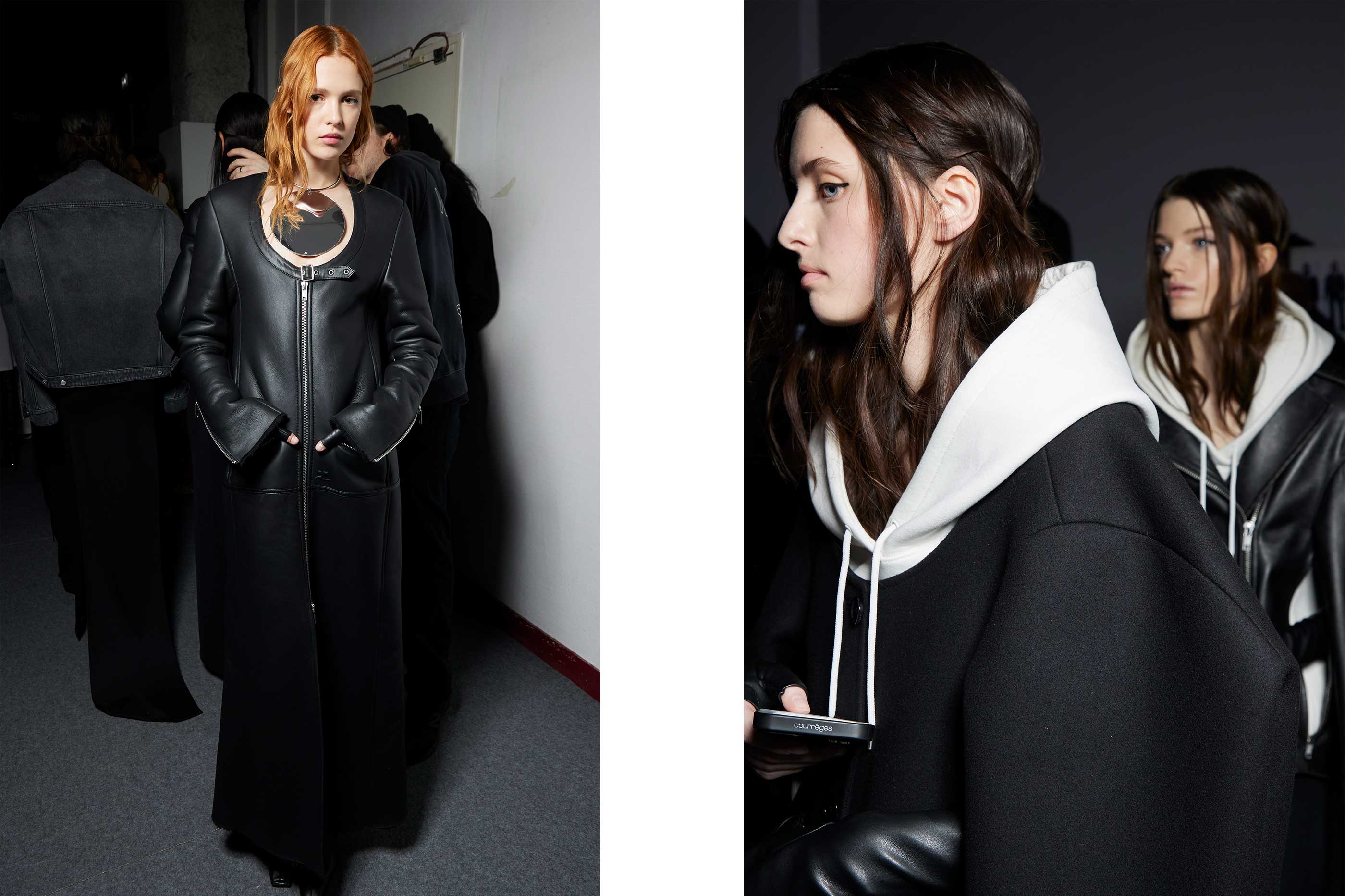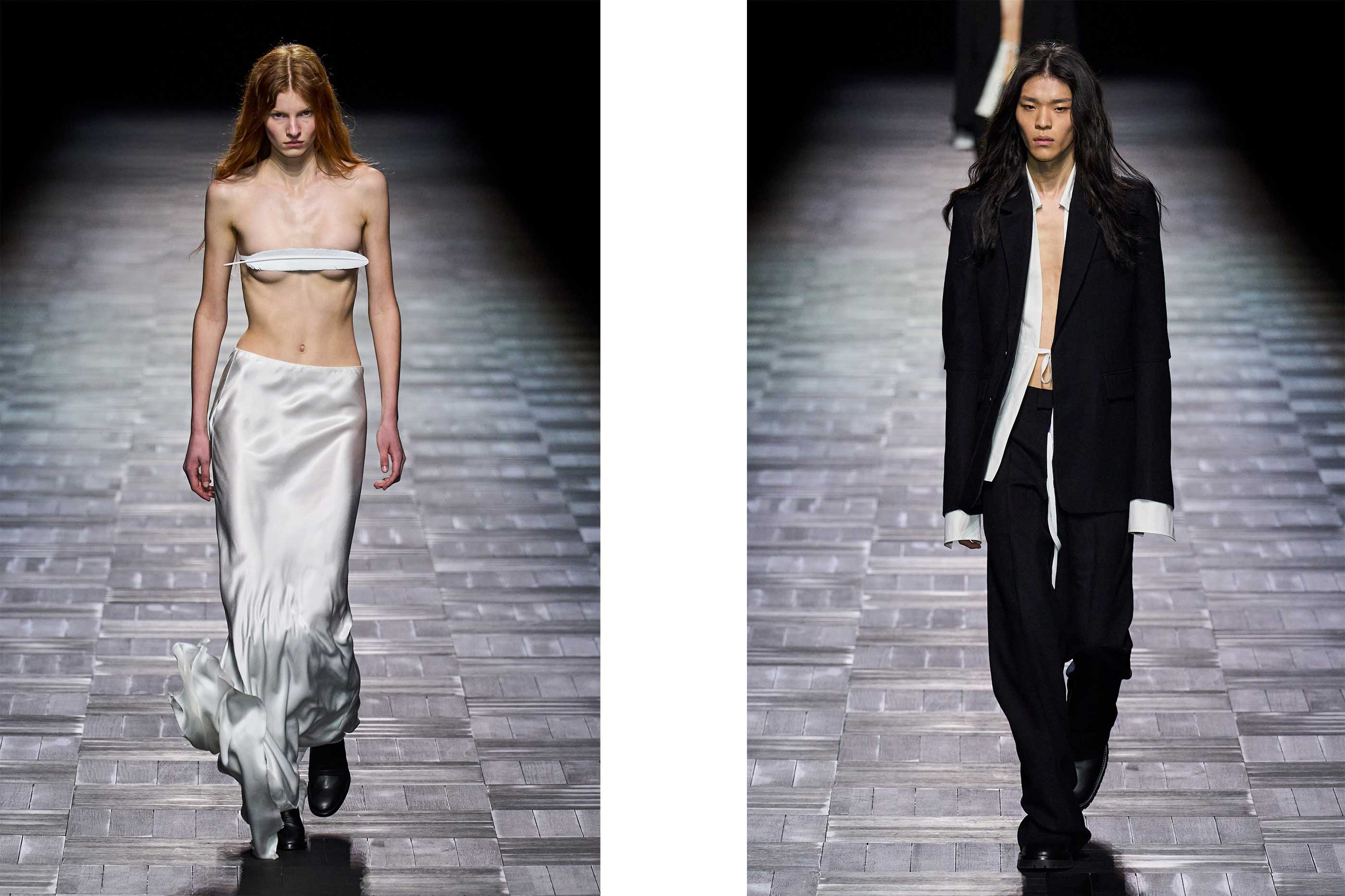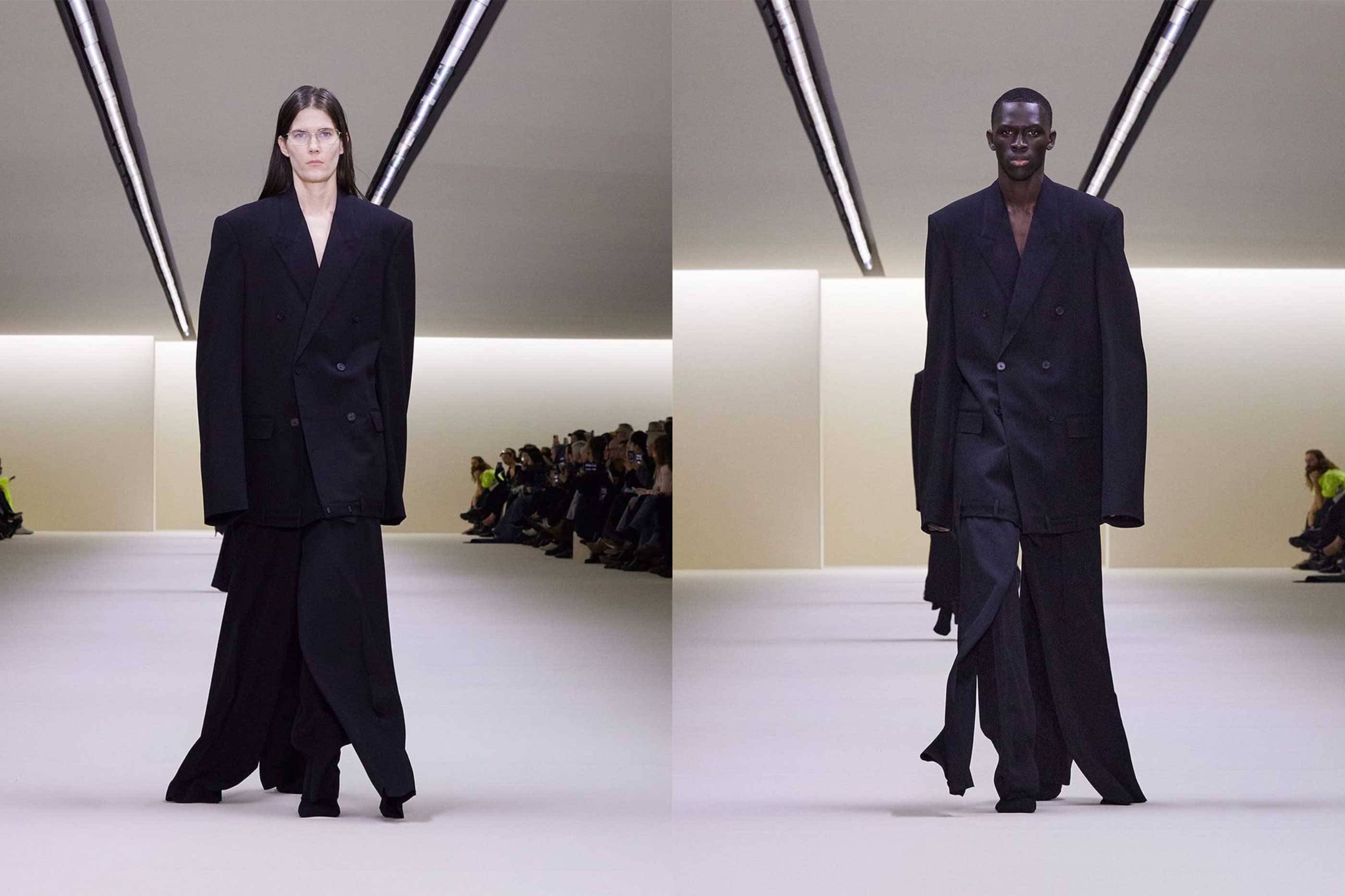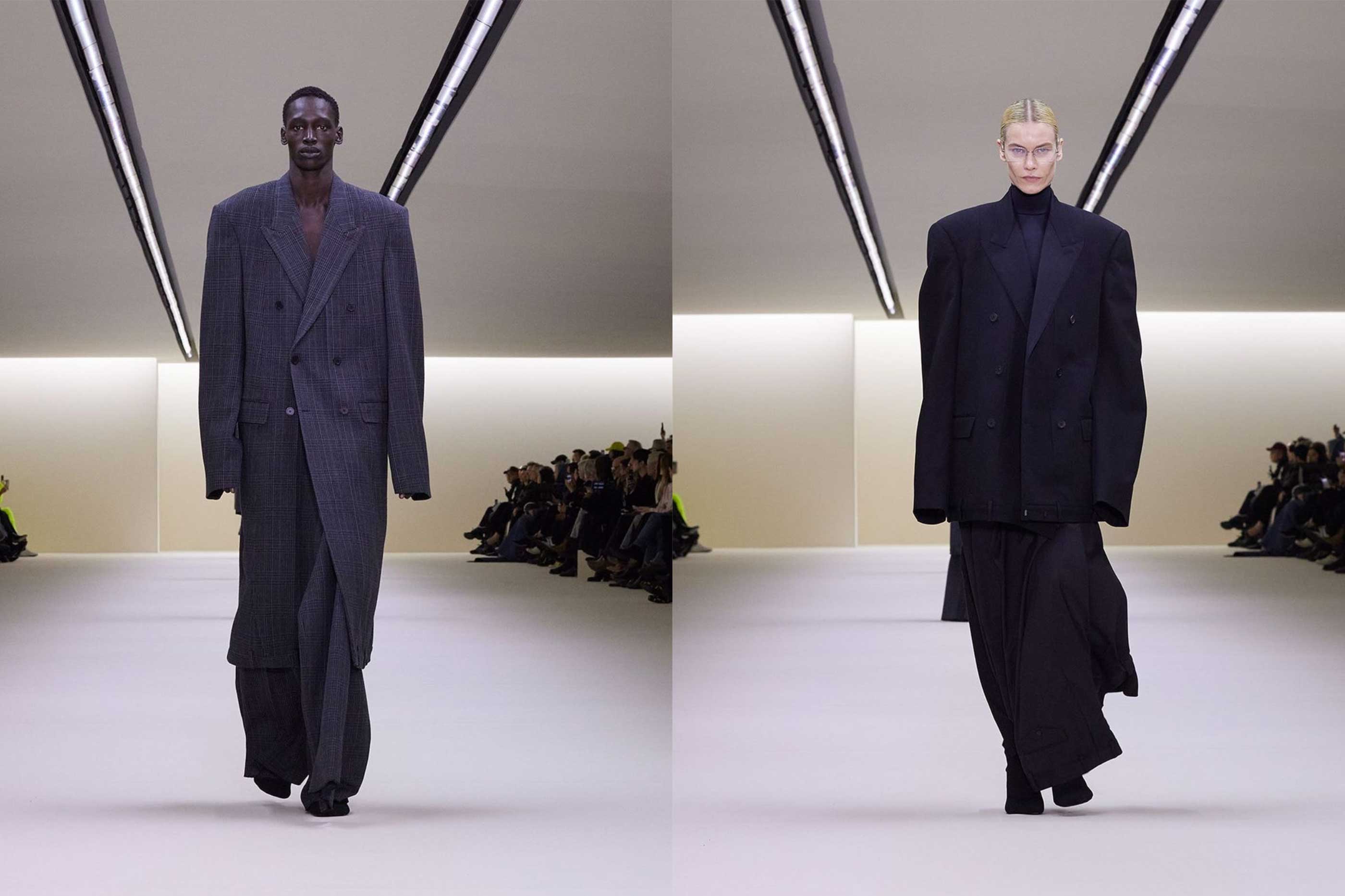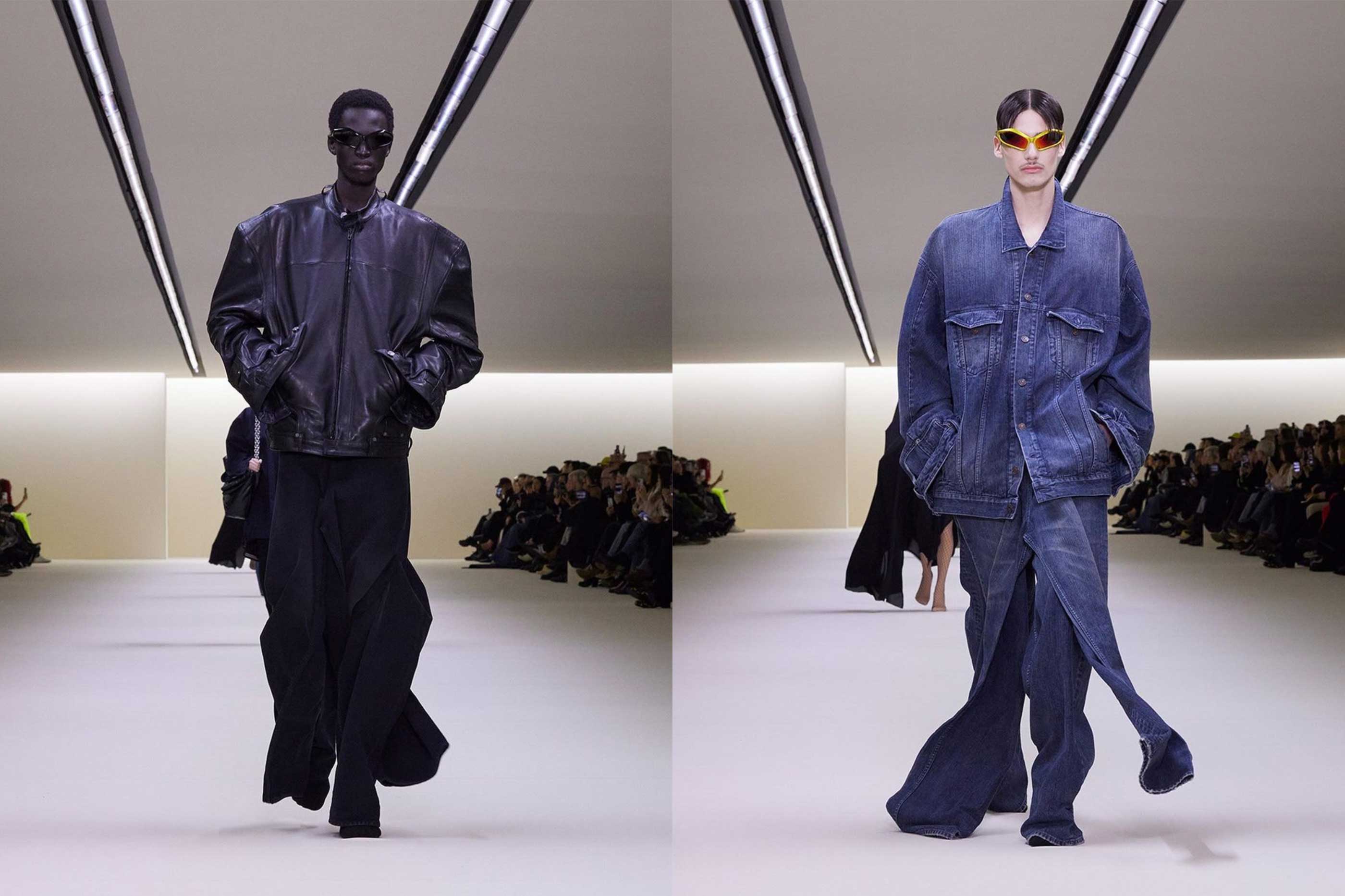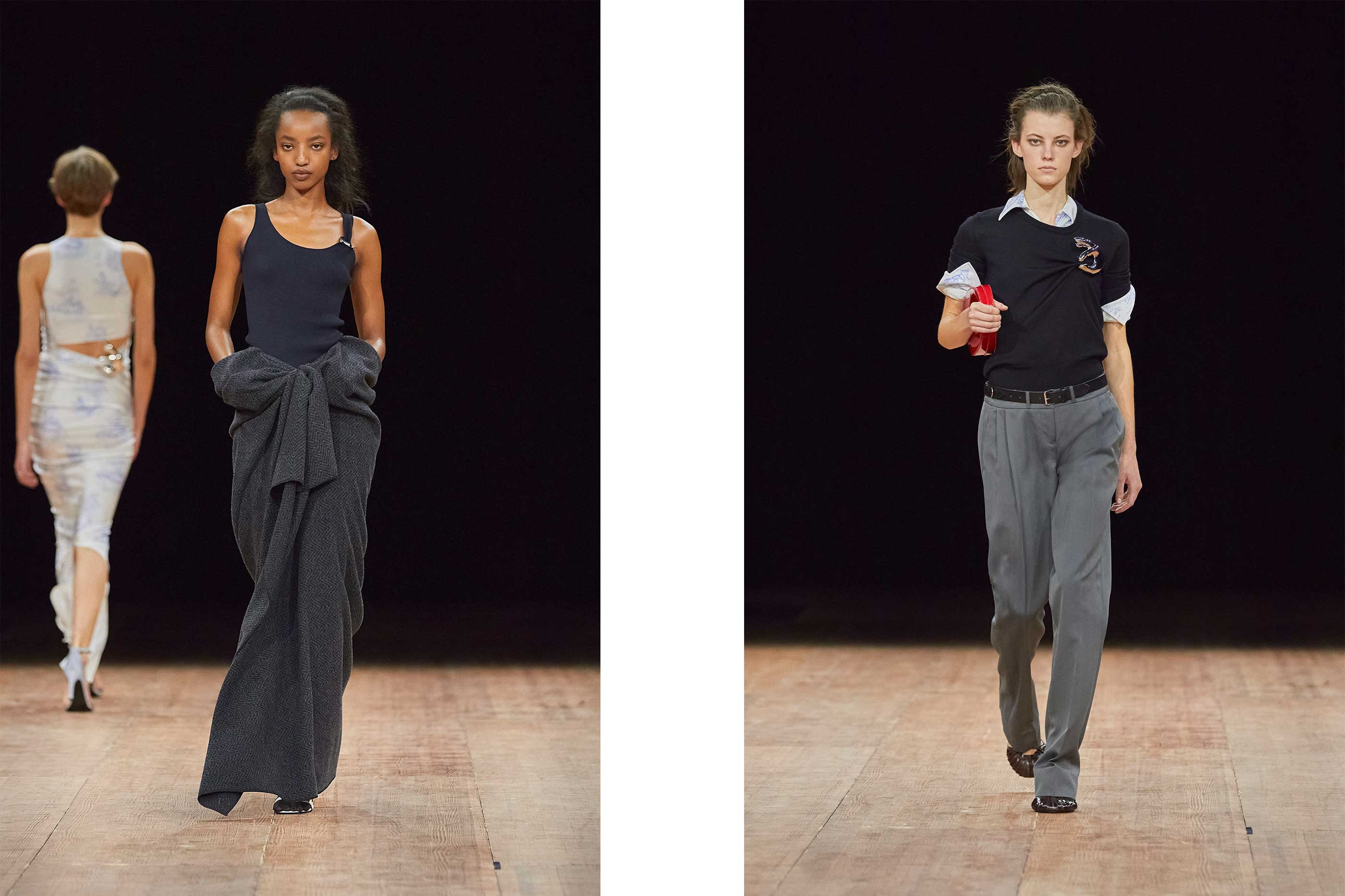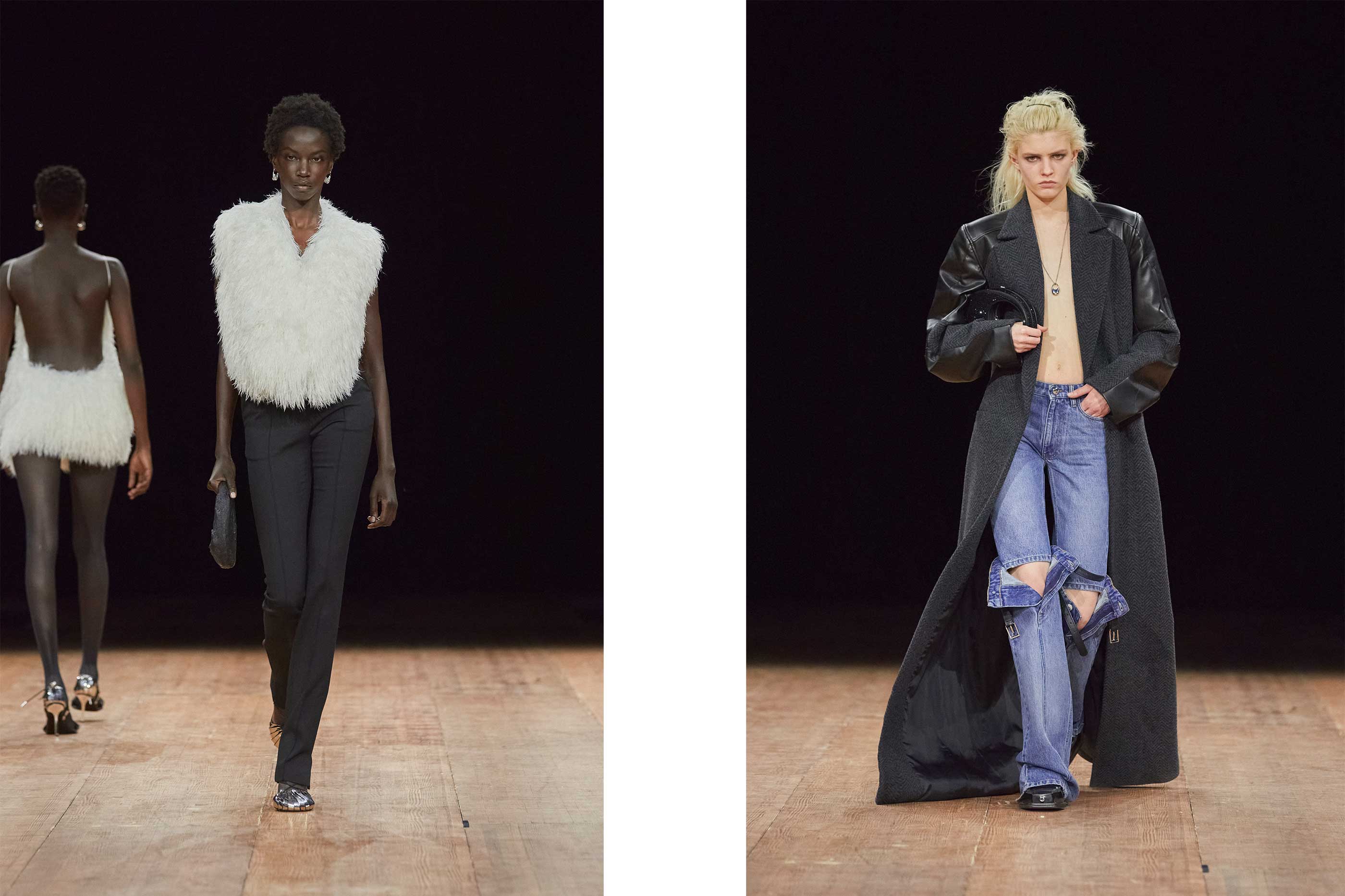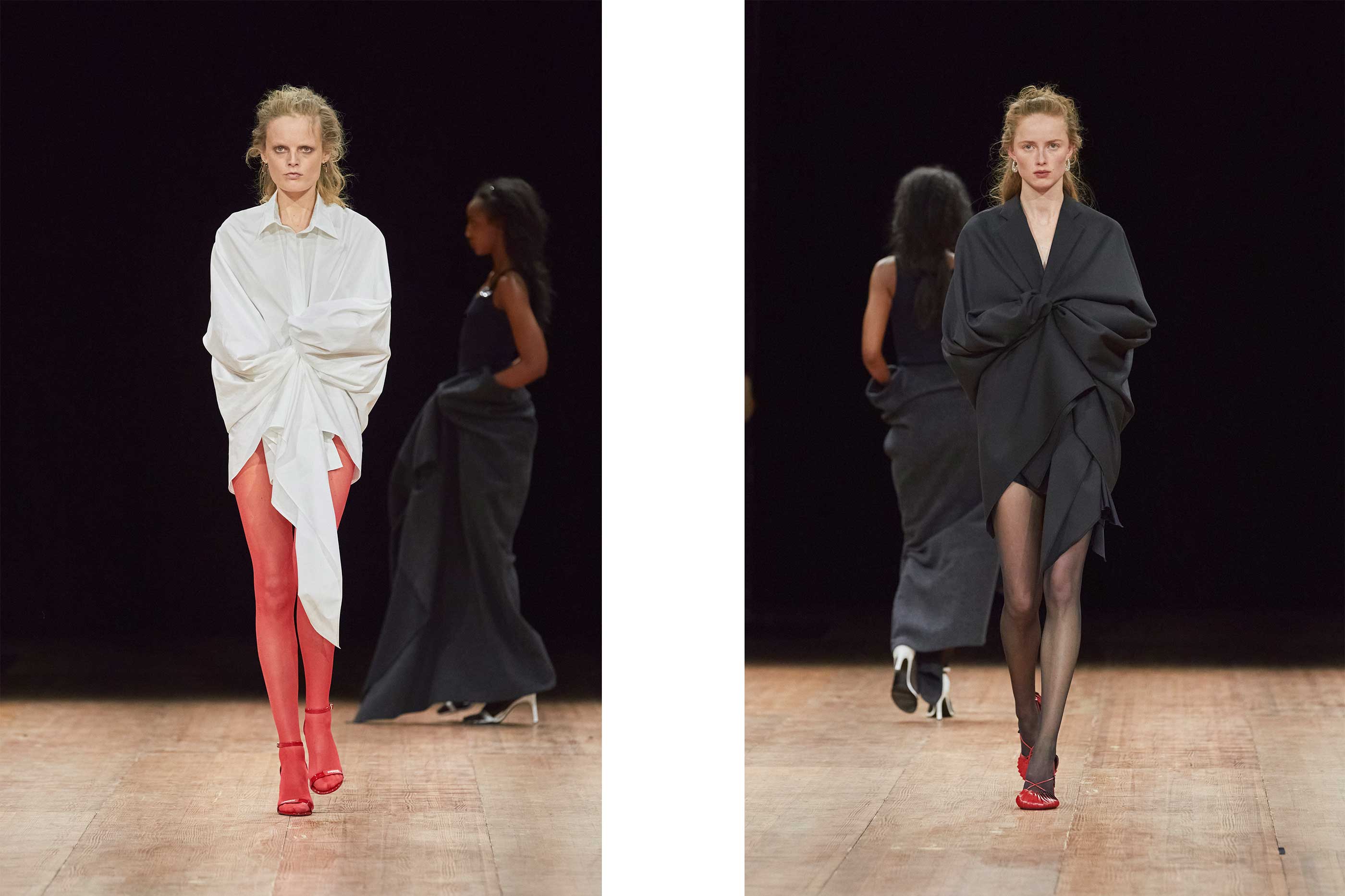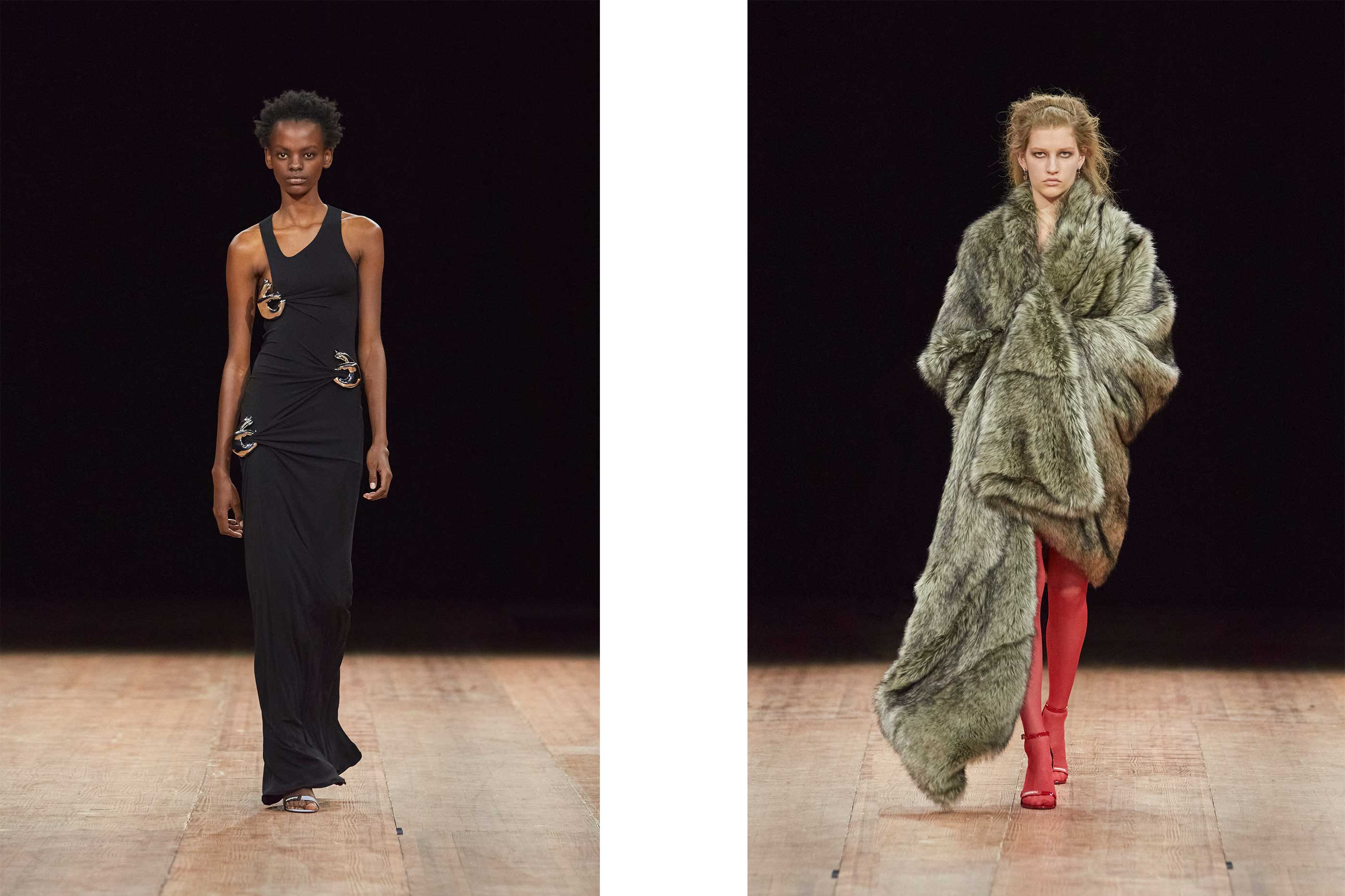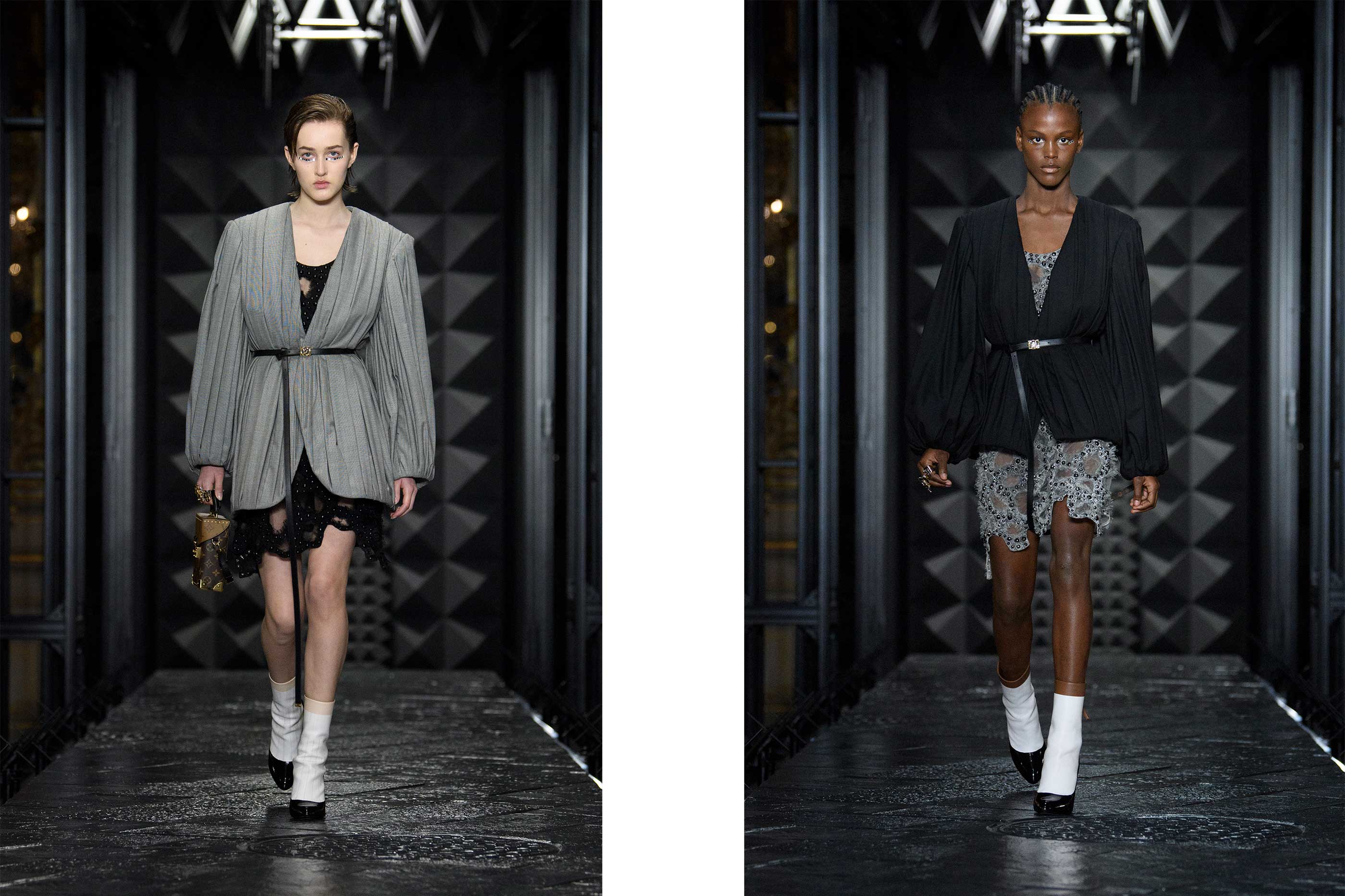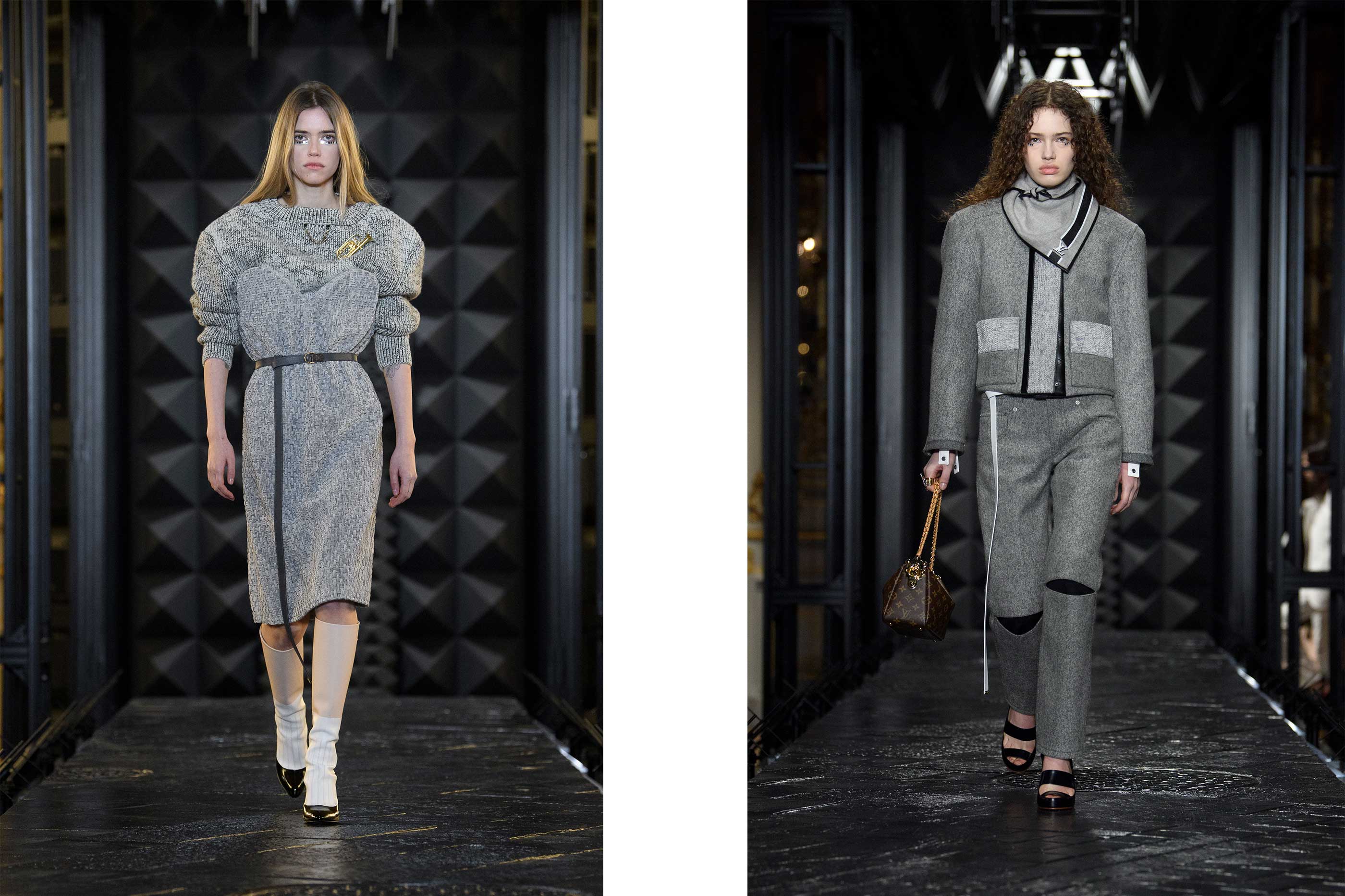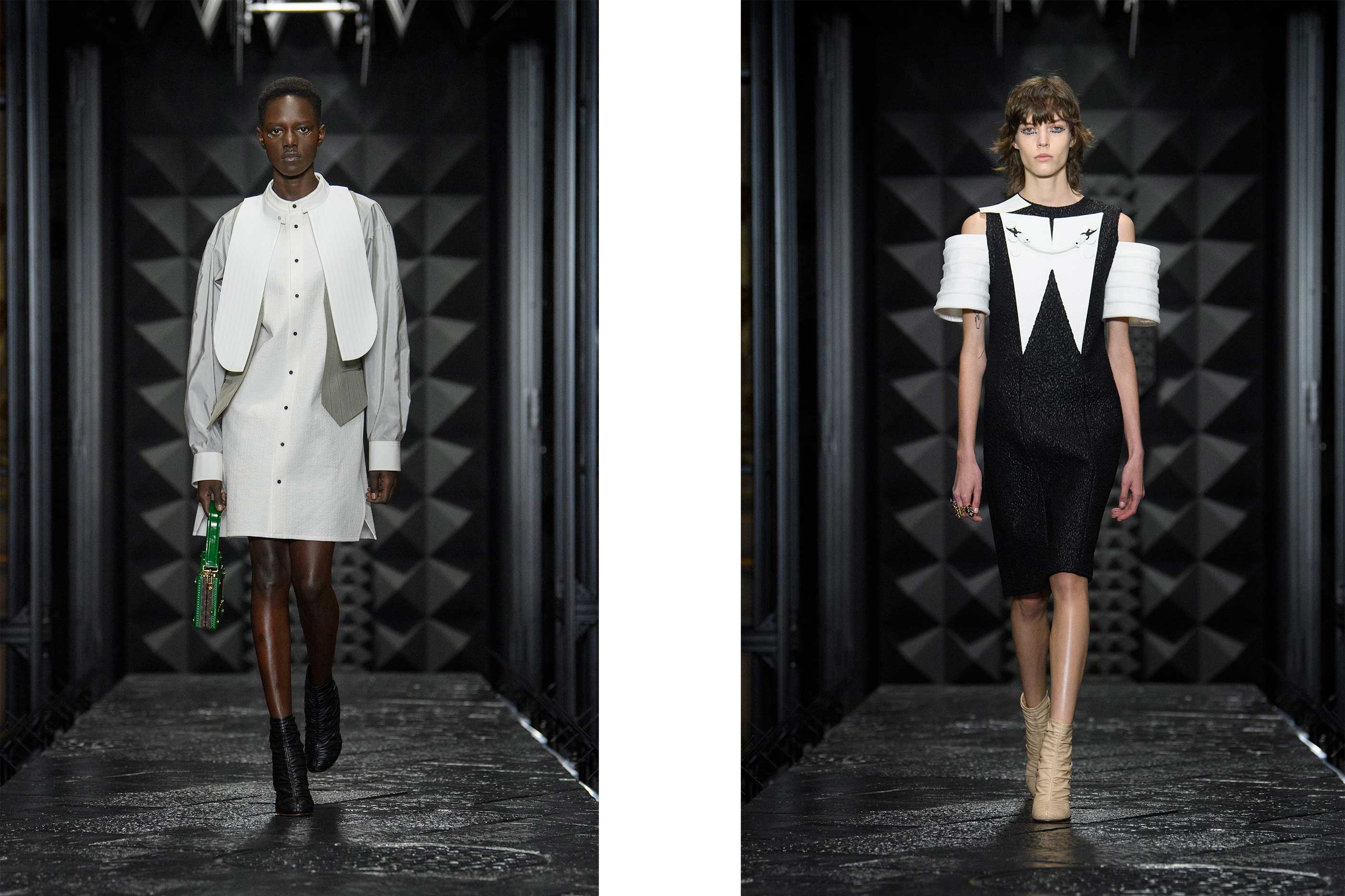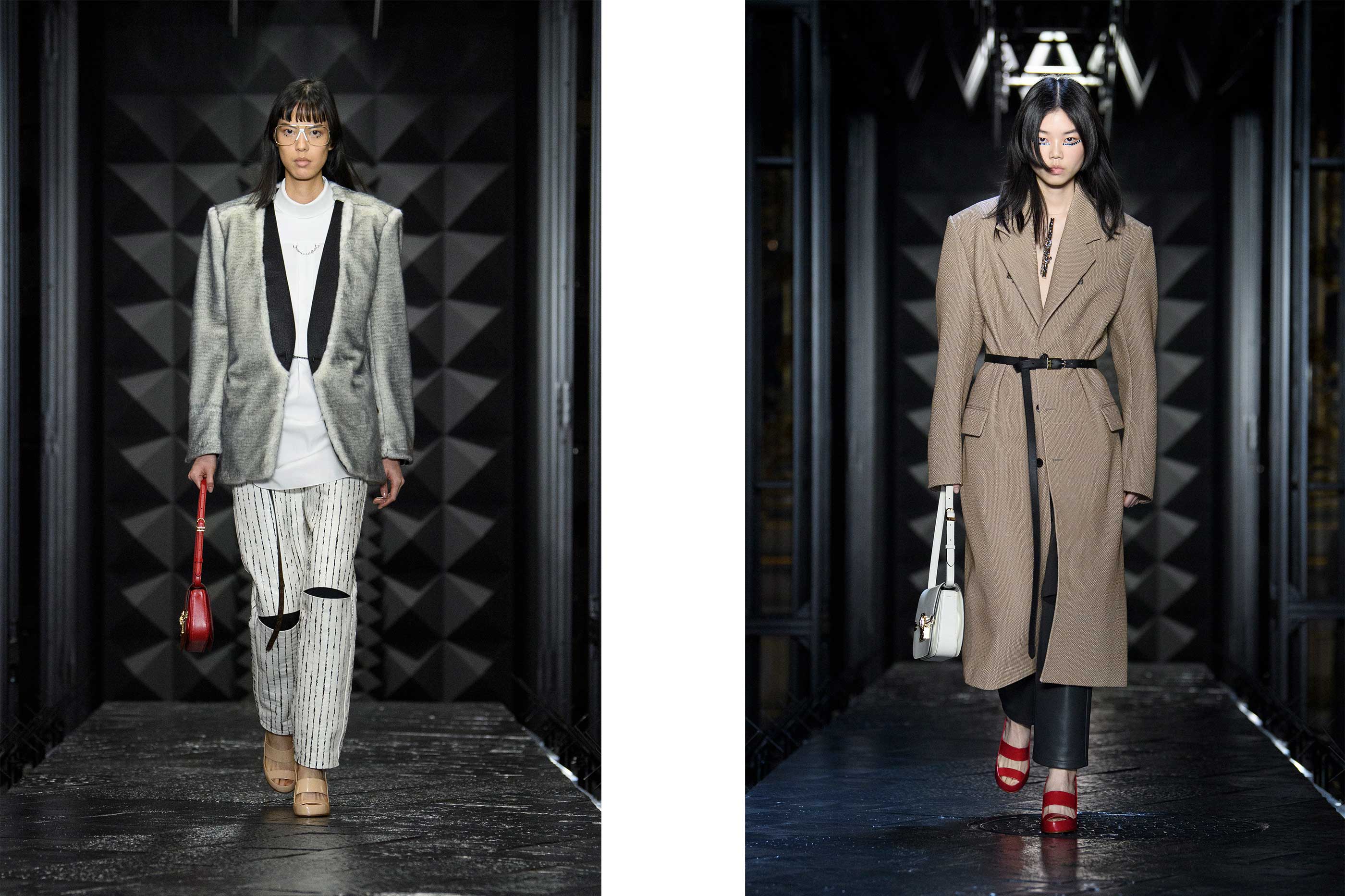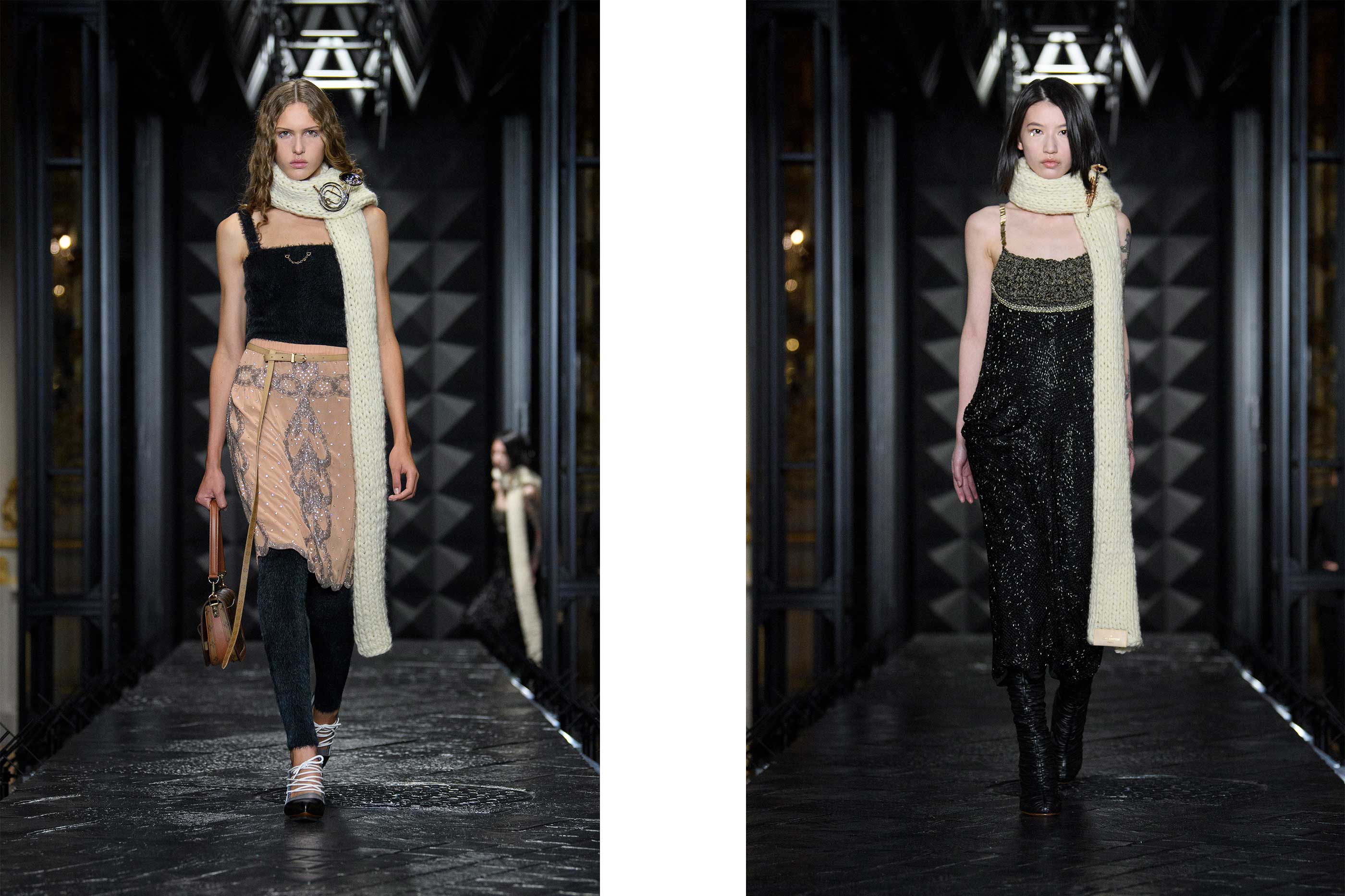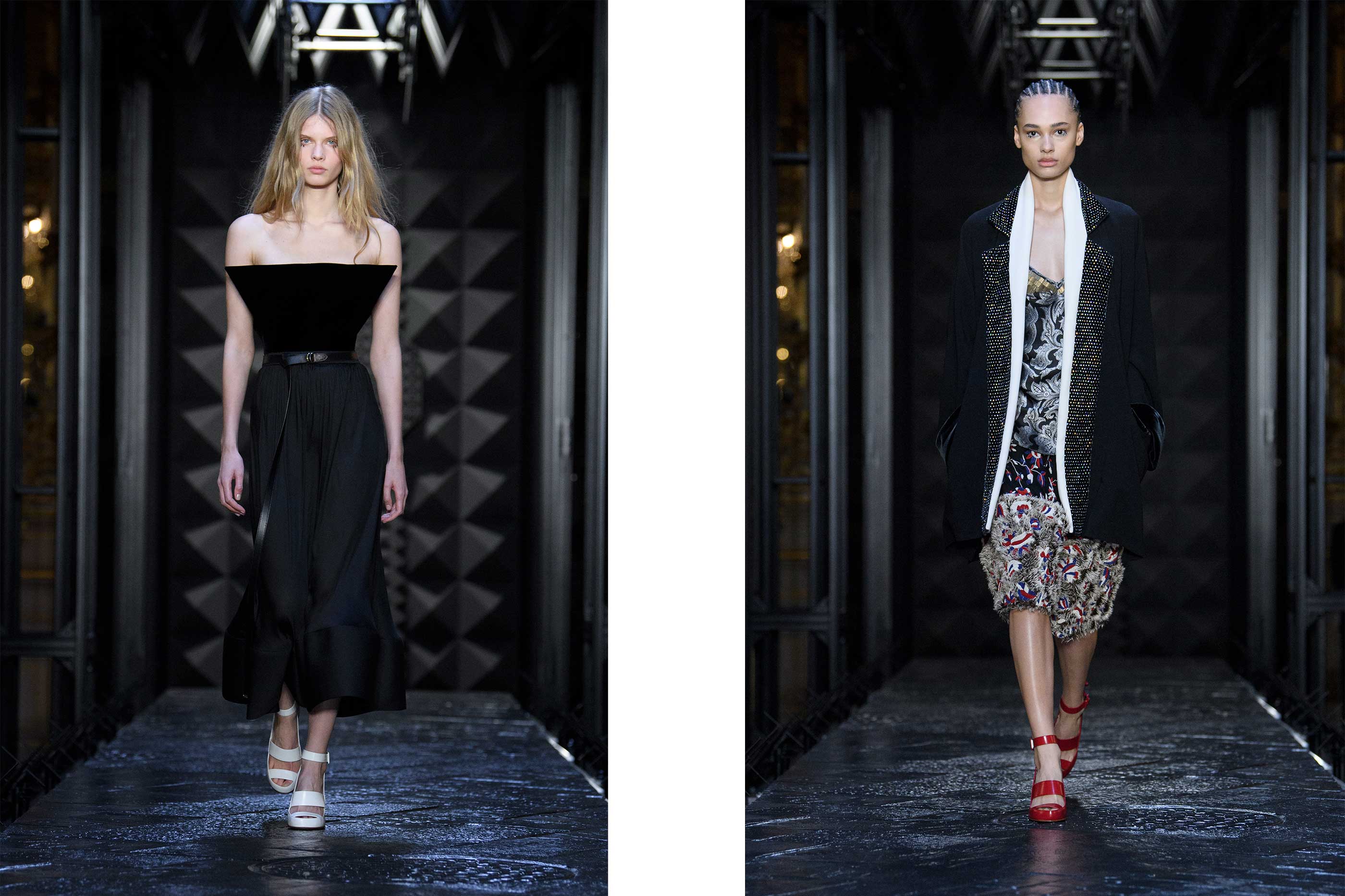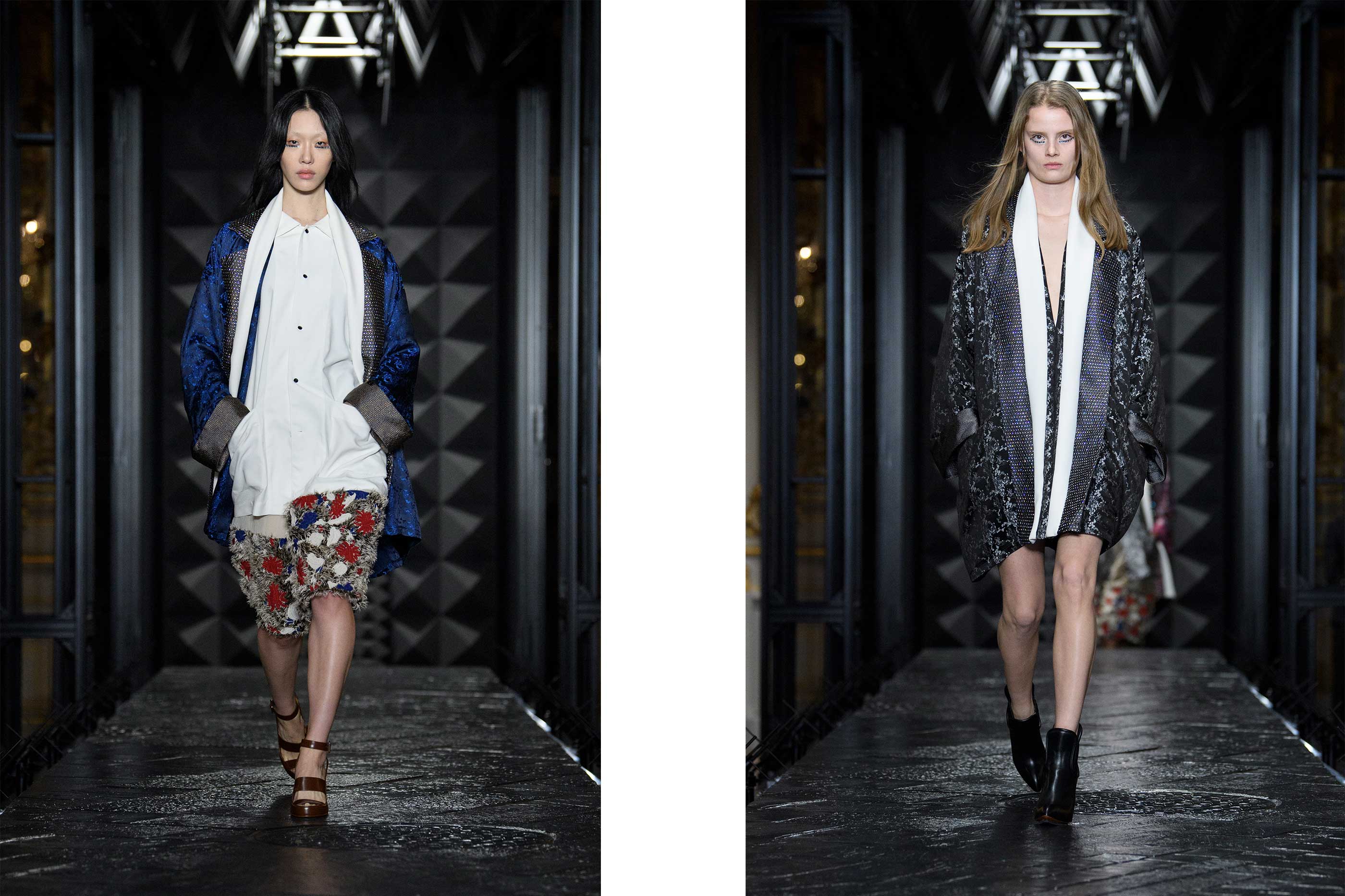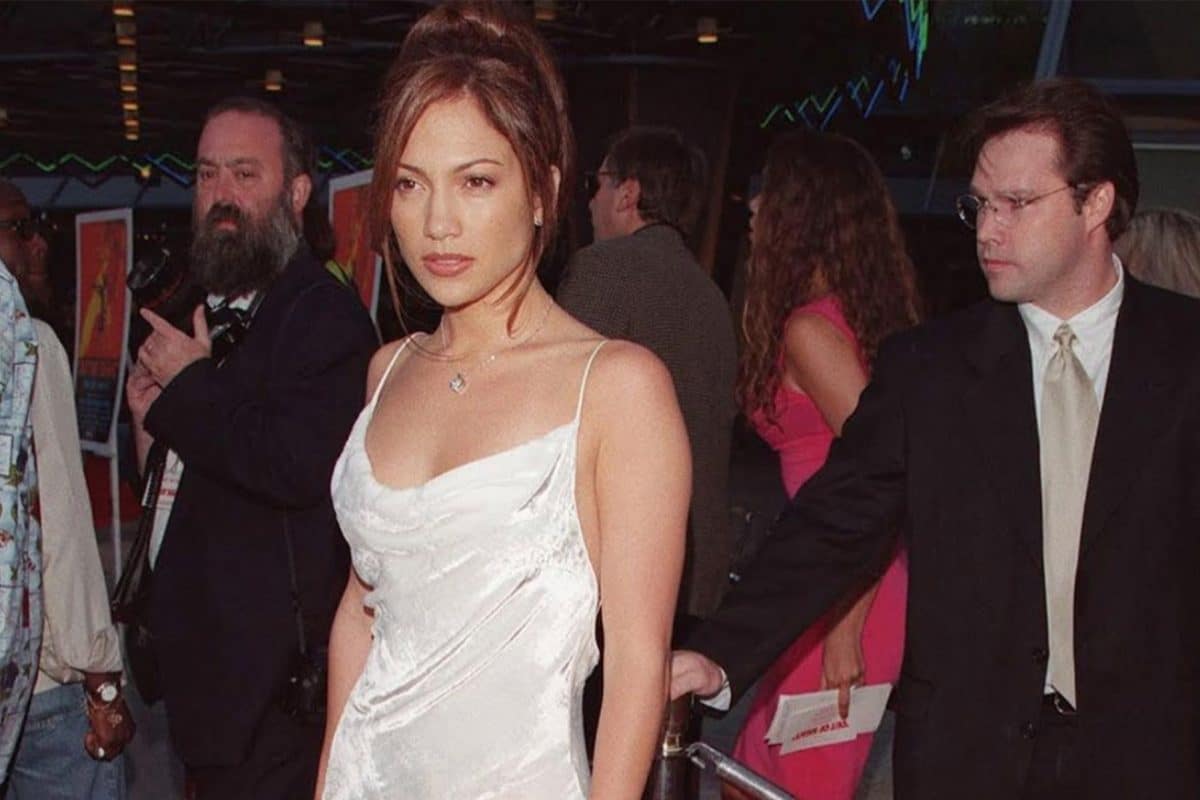
Bonjour Paris! The final stretch of fashion month for Fall 23 is here, and what a way to finish the season. 66 runway shows, 41 presentations, and, as Style Not Com recently calculated, "196 hours of non-stop fashion" and "countless croissants, coffees and dramas". So far, Anthony Vaccarello has given us a pensive lesson on elegance at Saint Laurent, and at Dior, Maria Grazia Chiuri's muses of the moment were the post-war women of the 1950s. A tribute to the late Paco Rabanne came from current creative director Julien Dossena, while at Courregés, it was all about the iPhone. Below, we're rounding up the best of Paris Fashion Week so far.
Saint Laurent
There is one thing that Anthony Vaccarello does almost better than almost anyone in the business. Beyond cohesive ideas and expert tailoring and dramatic shows, he has a knack for creating a vision that you want to be part of. It feels simple, really, but to possess the ability to create a fantasy of a woman that people really want to be feels like a rarity these days. For Saint Laurent's Fall Winter 23 show, this felt like more of a moment than ever.
It boiled down to elegance at the end of the day. A pure, concentrated, almost painful display of true elegance. It was almost decadent in its delivery: a plush yellow gold carpet on a raised runway lit by chandeliers set the scene for tight, focussed tailoring. Skirt suits aplenty – just as Yves would have liked it – emerged with big, big, big, shoulders, exaggerated on every jacket from pinstripe to smoking to tweed and velvet, all rendered in menswear materials (also as Yves would have done). Neat, slim skirts finished just above the knee elongated the leg; they were paired with these epic jackets and things like simple t shirts and plunging silk tank tops and flouncy blouses.
Vaccarello's current fixation with 80s silhouettes was ever-present, but this season it felt even more refined and exacting. For each moment that felt like it might tip over the retro edge, a current element would come screaming to the rescue. Mostly, this was down to the use of modern fabrics and Vaccarello's astute ability to cut in a contemporary way. He has been doing this for long enough to know that theatrics and tricky, trendy silhouettes only gets one so far, and as we've been witnessing more and more this month, focussing solely on the clothes is always going to feel like the most deliberate way to display craft. – EO
Christian Dior
Absurdity is the law of the current fashion landscape. Last season, it was the loudest voice and the most viral moment that cut through. To counter this, Maria Grazia Chiuri peeled it back to post WWII austerity for Christian Dior Women's Fall Winter 23. But sombre doesn't mean sexless, nor does modest mean an absence of luxury.
We don't remember the 50s as a time for liberation, especially when compared to the decades that followed. But the independence attained during WWII, especially for European women, emboldened a new generation of feminist and resilient figures. Chiuri counts her own mother and grandmother as part of this cohort, and anchors Dior Fall Winter 2023 around three Dior clients of the same milieu: Juliette Gréco, Edith Piaf and Monsieur Dior's sister, Catherine.
Maria Grazia Chiuri has injected elements of her own world into the collection also. Be it through the lightness of design, a gesture towards the practical dress bred in the Mediterranean where she is from, or the many decades she herself has lived through (the grunge inflections – combat boots, chokers, mohair argyle pattern sweater – on the New Look cannot be ignored).
Under the watchful gaze of Portuguese artist Joana Vasconcelos' textile installation, Valkyrie Miss Dior, Maria Grazia Chiuri presented a new uniform for our post-pandemic world. There were leather gloves and berets and circle skirts and pencil skirts. But most importantly, Dior Fall Winter 2023 is devoid of spectacle or excess, instead infused with the confidence and deliberation of our predecessors. – JP
Paco Rabanne
It was the first show since Paco Rabanne passed earlier this year, and to commemorate the moment, Julien Dossena paid tribute to the late, legendary designer and his relationship with Salvador Dalí. Sentiments of surrealism were woven through the collection at every turn. The Trompe L'Oleil effec tof materials in full swing: fur is in fact just very fluffy wool; metal mesh morphs into leather; printed dresses depict four scenes of Dalí's – including The Shades of Night Descending (1931) and Sun-Table (1935) – that become both distorted and dimensional through assembled panels, just as Paco would have done.
The most notable part of the tribute naturally came at the end, where Dossena brought out five archival dresses, worn on Jane Birkin and Francoise Hardy, alongside a voiceover that echoed over the soundtrack. They were the seminal pieces that show why we still know the name Paco Rabbane today, there wouldn't have been any other way to put it. – EO
Courrèges
The first model at Courrèges emerged in a hoodie. Cut on either sides of the waist, were armholes for easy access to her cellular device. Her face was lit up but the blue light of the screen; her and the next few models after her, walking and texting down the runway. It was, predictably, an uncomfortable watch. Instead of the freshness of last season – confident women with their pumps in their hands as they strolled through the sand – for Courrèges Fall 23, things felt as though they had taken a slightly more dystopic turn, especially with an AI-generated voice repeatedly asking "is the sky blue?" throughout the show space.
Nicolas di Felice's commentary didn't exactly feel negative, even if rather ominous. Instead, it was a simple comment on the paradigm we are living in – one that is chronically online. Semi-theatrics aside, the collection felt of the moment too. There were knee length leather skirts and tailored jackets with oversized, rounded shoulders and nipped waists. Shades of black and grey permeated the collection, as did giant, circular mirrored pendants, some of which were laid into chest cutouts on shirts, others were placed in the middle of the torso's of 60s, A Line shift dresses which felt a little teletubbies and also like a small nod to Paco Rabanne.
At the end, a spotlight hit the last three exits, each model wearing a different iteration of sheer sequin dresses. “The sky is blue,” the AI voice rang out. “Do you see me? I see you.” – EO
Acne Studios


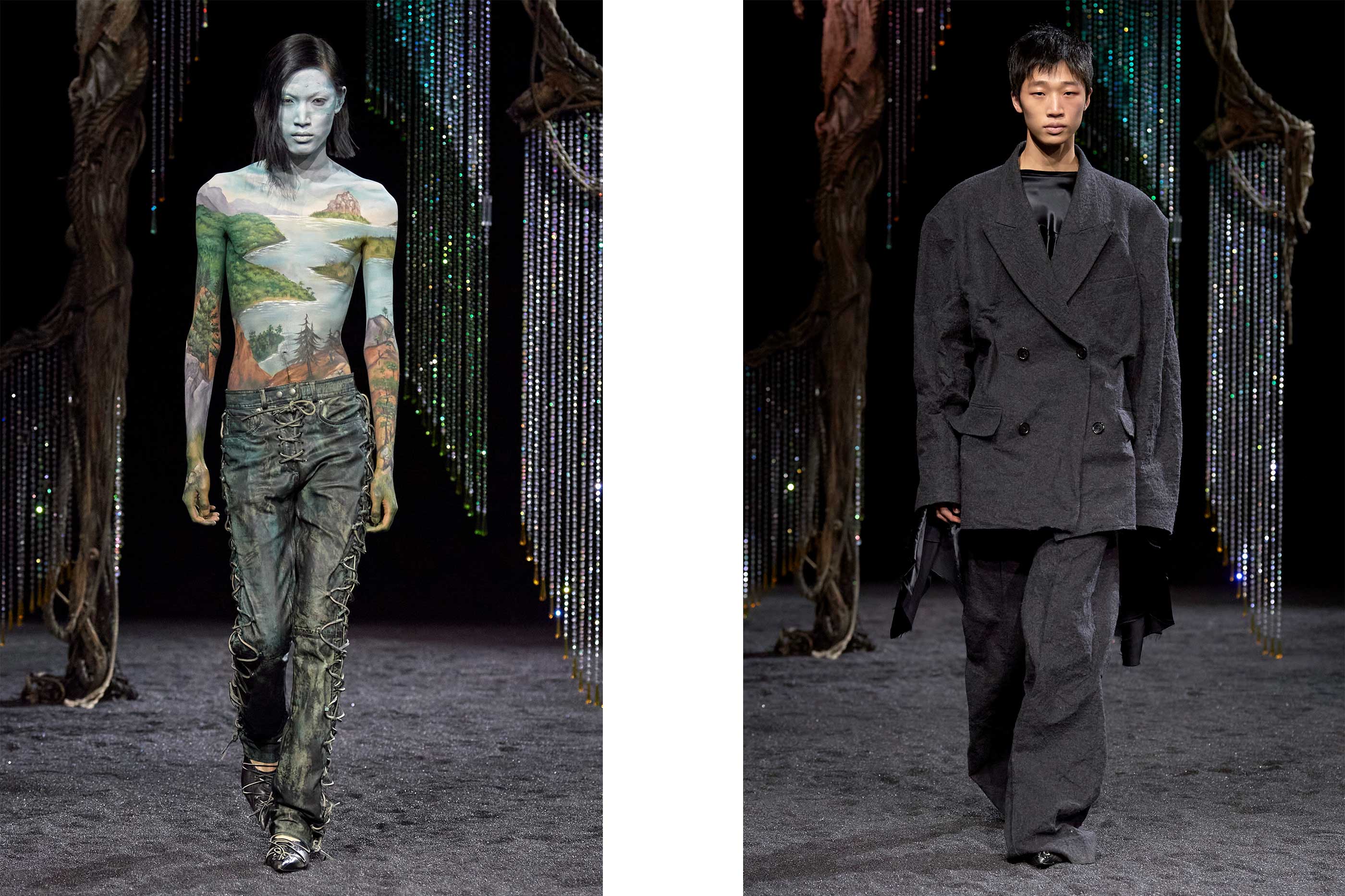
Jonny Johansson's vision for the Acne Studios Fall 23 show was the woodlands. More specifically, where the designer grew up in northern Sweden. In comparison to di Felice's commentary on technology and the urban environment at Courrèges, Johansson's collection was all about the natural world.
The first exit set the tone, with a distressed forest green dress made up of silk leaves that had been stitched together. Later, an orange skirt emerged with the same application. Models were given a nymph-like treatment, all swept over hair and sleepy eyes as they donned distressed leather and burlap-esque trench coats. Blazers were crumpled, the sleeved of knitwear hung well over the hands, glam apocalypse dressing was the message we took away, and if it means we can get away with not steaming something once in awhile, we'll run with it. – EO
Schiaparelli
It was Schiaparelli's first ready-to-wear collection in the history of the House, and despite the internet ruckus that Daniel Roseberry's last couture show caused with the decision to use fake animal heads on the busts of gowns, Roseberry's resolve has not been shaken. It was reportedly a collection to buck against conglomerates with consumer targets instead of creative ones. A collection that recognised many of the codes that Elsa herself established and Roseberry has riffed on through couture, only adjusted for "everyday", whatever that means in the context of Schiaparelli's world is still a little unclear. What is, is that it works for RTW. There were denim tuxedos with gold buttons, Aprés-ski puffer jackets and clingy jersey dresses. Cardigans were worn over leggings and skater skirts were paired with jackets that had been cropped and nipped in at the waist. The progression worked in Roseberry's favour, and we finally have an LBD to wear to dinner. – EO
Loewe
We expected nothing less from Loewe when Jonathan Anderson sent out a collection of silk dresses with blurred prints of other garments on them. We knew he'd be continuing his exploration of deeply surreal, yet somehow highly wearable and exciting pieces with his evolution of technique and knack for making a comment on current cultural phenomenons. There were tops and pants covered in feathers to make models look like Big Bird, and pastel, padded t-shirts and skater skirts that looked like they belonged on a Polly Pocket. In between the buzzy, Trompe L'oeil pieces were the cuts that always ground Anderson's vision, and makes it so successful too. Uncomplicated leather trench coats and Jersey dresses, slouchy oversized cardigans and bags to match. Refined, classic, a little bit fun. Anderson does it again. – EO
Ann Demeulemeester
As much as Balenciaga's post-scandal return to the runway would likely be the most talked-about moment of Paris Fashion Week, Ludovic De Saint Sernin's debut collection as the newly appointed creative director for Ann Demeulemeester would still be playing on our minds. The spectacle of a debut did not disappoint in this case. De Saint Sernin mirrored both opening and closing looks with black and white versions of long, bias cut silk skirts with feather bralettes – if you could call them that – to cover the bust. The tailoring was a triumph, Ann would be proud, and the silhouette that was created from models walking in long swaths of silk, only their hands cupping their breasts, was one that will linger for more than a moment. De Saint Sernin has garnered a reputation for sexy, fluid, pieces crafted from silks and chains and lace-up speedos, so to see his range put to use feels exciting. We're looking forward to seeing how he expands on the Demeulemeester brand, and how much deeper he can explore the codes of the house, in seasons to come. – EO
Valentino
At Valentino's Fall Winter 23 show, Pierpaolo decided to take the black tie memo quite literally. It's been back in fashion of late, and Piccioli's decision to design a collection around it, and the commentary the tie is traditionally associated with – as a symbol of masculine power, an emblem of orthodoxy and restriction – feels like an astute one, that follows his trajectory of quietly bucking against tradition in a measured and thoughtful way. What fun it was explore with, too. Tied tight, untied, paired with crisp poplin shirting and fluid shirt dresses, layered with perfectly structured jackets and long evening coats. It appeared at the necks of sequin ballgowns and somehow found its way into collared halter neck party dresses. Here, Piccioli reconsiders the meaning of uniformity in a way that feels completely cohesive. – EO
Balenciaga
All eyes were on the Balenciaga Fall Winter 23 show on Sunday to witness what Demna's redemption arc would be following the global scandal that enveloped the brand late last year. Last month, the brand announced a multi-year partnership with the National Children’s Alliance (NCA.), and in an interview that followed the news, Demna proclaimed that the shock-value tactics associated with the image-making and shows he had employed in the past would be a thing of just that. It informed our expectations for the show on Sunday, which, set underground in the Carrousel du Louvre – a space that was designed specifically for fashion shows in the 90s – acted as the place of Demna's pledge to return to the roots of Balenciaga.
It's a brand that is over a century old. One that was built on squared-off tailoring and fluid tunic dresses, and the shade of black. This was most obvious in the first few exits, where a series of double breasted black and grey coats and jackets emerged onto a plain, cream carpeted runway. There were 17 looks that followed this silhouette in total, all super-sized shoulders and long, austere lines. It wasn't too dissimilar to how many of Demna's shows start. The change here – propelled by Demna's proclamation that he would be returning to simply making quality clothing – was in the hems, where pant loops and pockets sat right above an extra pair of pants fastened onto the hips. It created a doubled over effect and a slight optical illusion as the pants swung in front of the tailored trousers the models were actually wearing. According to his show notes, this was a nod to his earliest memory of fashion design, when his family let him have his own pair of pants made by the local tailor.
Elsewhere, Demna's signature silhouettes reappeared. His floral jersey pleated dresses and sports-adjacent shapes made themselves known. Sock boots remained omnipresent and speed-dealer sunglasses remained on the bridges of noses. It wasn't the design overhaul that perhaps people had anticipated or suggested, but it did feel as though it was a more serious approach without the sets and the shocking accessories. One thing – the biggest thing – that did not reoccur, was the logos that have driven the brand forward from a cult-consumer perspective in the past decade. Naturally, as everything will be moving forward, it was a very conscious decision on Demna's part, and felt like a very serious stake in the ground to reset the image that Demna had been carefully creating for the past 10 years. – EO
Hermès
At Hermès' Fall Winter 23 presentation, it was all about the hair. Nadège Vanhee-Cybulski had apparently recently cut her own off, and the action served as a starting point for the collection. The palette was the focal point here, with 7 deep red looks all coming out at once, followed by all sorts of different tones of hair colour like copper brown, amourette brown, brass yellow, blond beige, rose gold and moonstone. There were blanket coats and ribbed knits of wool and silk, belted trench coats in billowing alpaca wool, quilted jackets and hooded coats in smooth calfskin or wool and cashmere flannel, long duffel-style coats in double-sided cashmere, zip-up coats in shiny lambskin, all rendered in these rich, autumnal colours that could blend seamlessly with a trip to the salon. – EO
Coperni
It's taken us a minute to fully wrap our heads around what went down at Coperni this season. The spray on dress that they showed last September as their finale with Bella Hadid had critics divided. For some, it was nothing more than a publicity stunt for a piece of the viral pie, for others, it was a thoughtful and inspired moment in a landscape that is frequently taken more seriously than believed it should. With this in mind, Sébastien Meyer and Arnaud Vaillant's decision to include a dialogue between five Boston Dynamics robo-dogs and the models who walked the runway could either be interpreted as once again making a mad dash towards having a viral runway moment, or doubling down on the conversation with technology that the design duo are hoping to bring to the front.
Either way, it got us talking, especially since it was more confronting to witness than we perhaps expected. Onto the clothes, there were some strong moments. The ready-to-wear offering feels increasingly exciting for the demographic they are talking to, with accessible tailoring and fun going out dresses. The pair were reportedly playing on the idea of Jean de la Fontaine’s The Wolf and The Lamb (the wolf being the robo-dogs), so the riding-hood-esque jackets that zipped right the way up to the chin and went over the head made sense here, as did a flash of red tights underneath a swath of faux fur coat. There were moments where models were wrapped in what felt more like masses of fabric instead of precisely cut coats which added to the lamb-like effect. Overall, what we're noticing is a brand who is trying to balance the art of conversation and concept with that of producing quality, successful collections. Will they succeed? – EO
Louis Vuitton
The theme of Paris Fashion Week this season has been somewhat of a returning to fashion's purpose. After a particularly buzzy past few seasons, where many brands focussed on tricky sets and celebrity appearances, Fall Winter 23 has brought back a sense of quiet confidence. Perhaps it's the season talking – after all, the colder months are often about inward reflection and thoughtfulness. Perhaps we're all just collectively fed up with theatrics that don't actually say something, especially if they detract from the quality of the clothes. This was acutely felt at Louis Vuitton's Fall Winter 23 show, where, in the Musée d'Orsay, on a raised platform meant to look like the cobbled streets or the floor of the old railway station, models walked silently to a soundscape of intermittent hurried footsteps, police sirens, the violin, cellphone ringtones, thunderstorms, and more.
They were the sounds of Paris (one can only presume), and they communicated Nicolas Ghesquière's Fall Winter 23 vision perfectly. Close your eyes and you're transported there, on the corner of Rue Du Bac looking out over the Seine, that perfect overcast Paris light illuminating hot breath and the cigarette smoke of a passerby. It was a collection that both questioned and pointed to the definition of French style. What is it? Why is the world fascinated by it? Mostly, it is an ineffable concept for only those who know to understand, but here, in the halls of d'Orsay to the sounds of metropolitan French life, Ghesquière offers a glimpse into the secret of French style.
Ghesquière is best known for his technical and sci-fi approach to ready to wear, however for Fall Winter 23, it felt as though he took a softer approach to his usual tricks, especially with the French woman in mind. This did not mean he wasn't full of clever high-tech ideas though. There were Phantom of The Opera sunglasses illuminated with neon lights and coats that appeared to be wool but were apparently actually embossed and printed leather. There were jeans that looked pinstripe, but featured hand-painted lines that were then stitched over with sequins. In terms of more classic offerings, waists were cinched in with long, thin belts that were knotted off and trailed past the knee; there were slouchy overcoats and blazers with trousers that swept the floor, all very Parisian woman on the go.

